
|
Otto Klemperer (1885 – 1973) is esteemed as the last eminent conductor trained in the traditions of the 19th century that produced so much of our most cherished music. Yet his weighty late stereo recordings, while notable, obscure and distort our view of the rest of an extraordinary and variegated career by which he deserves to be recalled and treasured.
| →As with my previous article on the recordings of Bruno Walter, I should clarify at the outset that this is intended as neither a biography nor a comprehensive discography (for both of which I've suggested other sources in the references section below) nor as probing analyses of particular recordings or the underlying works. Rather, I've attempted to trace Klemperer's diverse recording career, emphasizing the phases most commentators tend to gloss over or ignore. |
More than with any other conductor of renown, it's hard to evade mention of Klemperer's daunting health issues and to speculate as to their impact upon his artistic outlook. Harold Schonberg calls them "a Job-like succession of misfortunes [and] blows that would have demolished a weaker person." Indeed a summary of his personal history reads like an index to a medical text: a thyroid infection; intense life-long headaches from a cranial injury after falling backwards off a podium; a brain tumor that affected his hearing and balance; subsequent operations that severed nerves, partially paralyzing his face and tongue, leading to a scowling appearance and difficulty speaking and swallowing; breaking his femur;
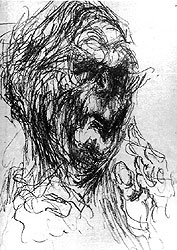 Klemperer by Feliks Topolski |
As if his daunting physical afflictions were not enough, Klemperer suffered as well from severe mental issues. As a young man he had experienced extreme mood swings which persisted throughout his life – enervating depressive stages in which he became withdrawn, melancholy, anxious, sleepless and self-critical, and hyper-active manic stages in which he was keenly focused but subject to fits of erratic behavior and explosive rage. It's tempting to attribute his readings of steadfast moderation or heightened energy at various stages of his career to these extremes. Yet Peter Heyworth cautions that the shifts between them were neither sudden nor radical and that Klemperer managed to achieve periods of equilibrium. Even so, his demons often defeated attempts to land a stable position, as his abusive temper, neglect of rehearsals and overall bizarre and erratic conduct alienated most of the orchestras he was engaged to conduct, leading several to pledge never to hire him again and at times relegating him to working with amateur groups. (A 1942 Wagner and Brahms rehearsal in New York with the Work Projects Administration Youth Orchestra finds him patiently struggling to wrest rudimentary cohesion, much less expression, out of the players.)
Something within Klemperer's shifts of temperament may have informed his ambivalent attitude toward formal religion and thus religious music. Born into an assimilated Jewish family, like so many others of his (and earlier) eras he converted to Catholicism in a generally futile attempt to satisfy the anti-Semitic cultural gatekeepers of the time. Heyworth notes that although Klemperer evaded dogmatism he might have taken comfort in the opposite belief that his damaging demeanor was a function of divine will and thus beyond his control.
 Woodcut by Ewald Dulberg |
By all accounts, Klemperer's attitude toward music was fully consistent with his personality. Although he apparently enjoyed the Hogan's Heroes TV series (starring his son Werner, of whose success he was glad) and Tom Lehrer's sardonic records (especially "Alma" and the "Vatican Rag"), humor was a distant stranger to his own music-making. In photos he never smiles and often looks grim and distracted, even in presumably happy times with family and colleagues. He reportedly rarely laughed, and then only sarcastically. His sense of amusement, such as it was, rarely went beyond an occasional pun that often seems more surly than witty (e.g., asking a musician flashing his watch as a rehearsal spilled into overtime: "Is it working?"). So, too, with his interpretations that became largely bereft of high spirits in favor of focusing on abstraction, proportion and balance.
His disposition was augmented by his sheer physical size. At six feet four he literally towered over all his associates and, moving with increasing difficulty, obliged them to adhere to his pace of life. For much of his career he beat time with his fists, thus precluding the degree of delicacy or subtlety enabled by supple manual gestures or a baton. He was obliged to sit at the podium, further impeding the use of expressive body language to communicate attitude. His appearance was described by one singer as that of a dark bird of prey and by a producer as centered around burning coal-black eyes. Intensively focused on music, he had little time for audience accolades or social functions. His marriage was strained and he came to rely on his daughter to manage his affairs.
Although a year after his peers (Walter, Weingartner, Mengelberg), Klemperer ventured into the recording studio at some point in 1924. (Studio documents were lost and none of the discographies specifies dates; even so, a chronology can be inferred from matrix numbers, which presumably were assigned sequentially.) By then he had risen through the ranks with increasing responsibility from choirmaster to music director at Prague, Hamburg, Strasbourg, Cologne and Weisbaden. In a notable departure from the customary repertoire that focused on overtures and other selections that could fit on a single double-sided disc, all four of Klemperer's Polydor acoustical recordings were of substantial symphonic works and two were phonographic premieres. (A fifth major work which would have been another premiere on records – the first Bach Brandenburg Concerto – possibly was cut but never issued.)
Beethoven: Symphony # 1 ~ This set boasts several "firsts" – not only Klemperer's first recording but the first full recording of Beethoven's first symphony. While collectors already could choose among multiple sets of most of Beethoven's other symphonies, the First had previously emerged only in part as a 1922 Grammophon disc of the first movement by the Berlin Philharmonic led by Hermann Abendroth (in possibly his first recording as well). Occupying seven sides (the eighth was filled with the Minuet from Beethoven's Quartet Op 18 # 5 by the Welding Quartet), after an introduction similar to Abendroth's Klemperer's tempos are more leisurely and with more graded dynamics and richer balances. 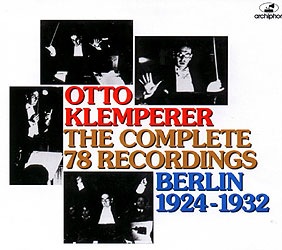 Both slow considerably for the second theme group, after which only Abendroth resumes the initial pace for the development and coda. Klemperer's remaining three movements boast lovely phrasing, attentive ensemble, a strikingly slow trio and subtly pliant pacing. The only acoustical recording to follow was a decent but rather bland 1925 take on Parlophon by Frieder Weissmann and the Berlin State Opera Orchestra (Staatskapelle), albeit with the finale pruned to a single side by omitting the repeat observed by Klemperer (and thus enabling the Parlophon set to fit on three discs, a marketing advantage). A fascinating comparison would arise in 1926 with the next Beethoven First by the Royal Philharmonic Orchestra led by Sir George Henschel who boasted unique pedigree – he was a pupil of Ignaz Moscheles who, in turn, was the devoted assistant of none other than Beethoven himself. Of all the conductors on record, Henschel is the closest link we have to the composer. While a reviewer of the time hailed the records as Henschel's "well known interpretation" and assured readers that "judging from this recording ... the distinguished conductor is far from impaired in his powers," his performance turns out to be genteel and metronomic. Although the First preceded Beethoven's revolutionary works, one still must wonder, despite somewhat more animated if steadfast middle movements, if Henschel's placid walk-through truly represents the aesthetic of the rebel who wrenched music from its complacent classical moorings into a new emotive era and, even if Henschel once had absorbed Beethoven's visceral temperament through Moscheles, whether his art survived to his only record. Thus even if the prospect is intriguing, the paradigm may be lacking for comparison to Klemperer's first recording.
Both slow considerably for the second theme group, after which only Abendroth resumes the initial pace for the development and coda. Klemperer's remaining three movements boast lovely phrasing, attentive ensemble, a strikingly slow trio and subtly pliant pacing. The only acoustical recording to follow was a decent but rather bland 1925 take on Parlophon by Frieder Weissmann and the Berlin State Opera Orchestra (Staatskapelle), albeit with the finale pruned to a single side by omitting the repeat observed by Klemperer (and thus enabling the Parlophon set to fit on three discs, a marketing advantage). A fascinating comparison would arise in 1926 with the next Beethoven First by the Royal Philharmonic Orchestra led by Sir George Henschel who boasted unique pedigree – he was a pupil of Ignaz Moscheles who, in turn, was the devoted assistant of none other than Beethoven himself. Of all the conductors on record, Henschel is the closest link we have to the composer. While a reviewer of the time hailed the records as Henschel's "well known interpretation" and assured readers that "judging from this recording ... the distinguished conductor is far from impaired in his powers," his performance turns out to be genteel and metronomic. Although the First preceded Beethoven's revolutionary works, one still must wonder, despite somewhat more animated if steadfast middle movements, if Henschel's placid walk-through truly represents the aesthetic of the rebel who wrenched music from its complacent classical moorings into a new emotive era and, even if Henschel once had absorbed Beethoven's visceral temperament through Moscheles, whether his art survived to his only record. Thus even if the prospect is intriguing, the paradigm may be lacking for comparison to Klemperer's first recording.
Beethoven: Symphony # 8 ~ For his other acoustical Beethoven symphony Klemperer faced competition – full recordings of the Eighth by Felix Weingartner and the London Symphony and Weissmann and the Staatskapelle, together with second movements by Hans Pfitzner and the Berlin Philharmonic and Leopold Stokowski and the Philadelphia Orchestra. Short and with compelling regular rhythms, the Eighth (along with the First) seems the least demanding of the Beethoven symphonies (and thus a "safe" way to launch a recording career), and yet Klemperer once insisted that it presented deep interpretive challenges. Here under his baton it emerges with tangible enthusiasm – accents crisp, surging tempos underscoring the structural contribution of each phrase, carefully-graded balances in the opening movement and extreme dynamics to propel the finale. In marked contrast, the Weingartner has a richer sonority but at the expense of submerging the string melodies beneath the harmony, palpable deceleration to mark transition points, a seemingly conscious deconstruction of the clock-like rhythm of the second movement and a rather gruff finale. (I haven't been able to locate a copy of the Weissmann. The single Pfitzner movement boasts light textures and chugs along merrily except for two lyrical segments, while the Stokowski is taken slower overall and tends to suggest a thoughtful undercurrent.)
Schubert: Symphony # 8 ("Unfinished") ~ The appeal of its melodies, drama and brevity made the Schubert Unfinished a natural for early recording. Indeed as early as 1912 three versions, albeit abridged, already had appeared (Pryor's Band on Gramophone; Prince's Symphony Orchestra on Columbia; the New Symphony Orchestra under Landon Ronald on HMV). By the time Klemperer's was issued it joined complete versions by Eduard M�rike and a "Symphony Orchestra" (presumably the Staatskapelle) on Parlophone, Leo Blech and the Berlin Philharmonic on Polydor, Adrian Boult and the British Symphony on Vocalion, Ronald and the Royal Albert Hall Orchestra on Gramophone and Stokowski and the Philadelphia Orchestra on Victor.
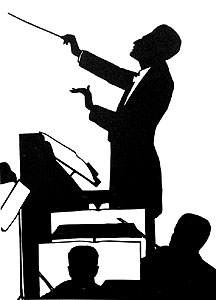 Silhouette by Elsa Pfiter-Kaufmann |
Bruckner: Symphony # 8 [Adagio only] ~ Using the 1892 Schalk edition and issued on four discs (the eighth side again filled by the Wendling Quartet, this time in the Andante of a Dittersdorf quartet), the massive second movement of Bruckner's Eighth Symphony was not only the most daring of Klemperer's acoustical recordings but one of the most venturesome of all non-operatic acoustical releases. Indeed, it was only the second recording of anything by Bruckner, preceded a month earlier by a complete Bruckner Seventh (led by Fried on Grammophon) that itself was a remarkable achievement, missing some of the sheer heft of Bruckner's textures due to the reduced forces imposed by the acoustical process, yet still managing to convey much of its essence; aside from a rather stodgy finale it's beautifully-paced, highly effective, and sparked by an especially bracing scherzo and gracious trio. (The import of its dim sonority becomes apparent with the first electrical Bruckner recording – another Seventh – by Jascha Horenstein leading the Berlin Philharmonic for Polydor in 1928.) While Klemperer's concerts of the Eighth had garnered great success and attracted much notice, in retrospect the choice of its Adagio seems surprising. The Eighth is among the most colossal of Bruckner's works, and yet its stormy outer movements or bounding scherzo would seem to have had more popular and commercial appeal, and their episodic form easier to convey, than the half-hour Adagio, which poses an especially severe challenge within the limits of the recording technology of the time, as the need to chop it into four-minute fragments, and the ensuing interruptions while listeners had to manually change the seven sides over which it was spread, damaged its essential continuity. Even so, the incessant build-up toward the titanic climax sounds remarkably constant nowadays when the sides can be joined, a luxury that listeners of the time could not have fathomed. Yet while the softer sections come across rather well, abetted by Klemperer's tight dynamic control and shapely phrasing, much of Bruckner's subtle layering of sonorities is lost amid wan sonics and the summit itself emerges as an anemic anticlimax. Perhaps the ultimate measure of the Eighth's resistance to the segmentation of the 78 rpm format and the limited fidelity of the acoustical process lies in the fact that its first full recording (by Eugen Jochum and the Hamburg State Philharmonic for DG) would await the LP era 25 years later. While the Bruckner Adagio may be the least gratifying of Klemperer's acoustical recordings, the sheer attempt amply testifies to the level of confidence that would color much of his later work.
As Adam Kurakin notes, Klemperer's brief but daring term at the Kroll Opera seems anomalous if not incredible to those of us who think of him as a figure of Olympian severity and a guardian of the "classical tradition" of mainstream German repertory.
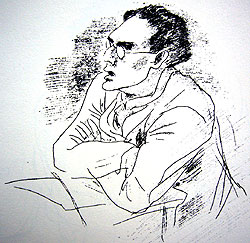 Klemperer in 1931, by Richard Ziegler |
Throughout his tenure at the Kroll Klemperer gave orchestral concerts with the Staatskapelle ranging from Bach to Hindemith, Janacek and Stravinsky. They cut 18 recordings, at first continuing with Polydor but then shifting to HMV and then Parlophone, but few approached the import of his acoustical sets, much less represented the stimulating repertoire for which he became known at the Kroll.
Beethoven: Symphony # 8; Coriolan, Egmont and Third Leonore Overtures ~ In a 1927 article, Klemperer asserted that the best way to celebrate Beethoven's centenary would be to ignore him for a year, since "everyone plays Beethoven and no one wishes to hear the men who write today. � Hindemith, I can perhaps help, make you understand his music. Beethoven, no. He does not need it." Yet during 1926-27 Klemperer recorded more Beethoven than any other composer (Brahms and Strauss tie for second place). Beyond slightly steadier tempos, omission of the first movement exposition repeat and better fidelity the new Eighth is nearly identical to the earlier set, with a similarly slender sonority from a seemingly reduced orchestra. The duplication of repertoire suggests commercial rather than esthetic motivation. Klemperer's prior recordings all had been made with the acoustical process in which the cutting stylus was driven directly by sonic energy gathered by a massive horn, resulting in unnatural resonances, reduced dynamic range, no genuine bass, curtailed overtones and the need to cram no more than two dozen musicians into a stiflingly small studio with no ambience. With the introduction of electrical recording in 1925, the sound of full orchestras in resonant rooms could be captured by multiple microphones with wider frequency response and controlled with mixers and amplifiers. Of the three Beethoven overtures Klemperer recorded during his Kroll years, the Leonore III would seem to give us a taste of Fidelio, the work with which he opened his Kroll tenure to great public acclaim despite critical reservations over the stylized sets and principals (the State Opera laid claim to the most accomplished singers). 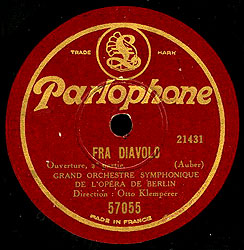
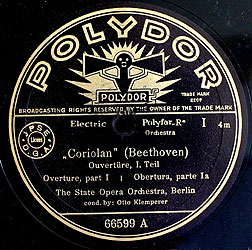 In a practice launched by Mahler, the Leonore III Overture, which recaps the drama, routinely is inserted before the final scene and yet, to critics' praise but audiences' dismay, Klemperer omitted it at the Kroll (and often later). He ultimately relented, recognizing that it serves to propel the opera into a higher realm, universalizing the trivial plot and clich�d characters of the human drama to prepare for the thematic power of the oratorio-like conclusion. As though to illuminate that view, his recording (coupled for release in an album with the Mendelssohn Midsummer Night's Dream Overture, each on three sides) is a fine blend of atmospheric reflection and moderated power, especially when compared to the crisp, excitable and more overtly dramatic contemporaneous accounts by George Szell and the Staatskapelle (Parlophone, 1925), Landon Ronald and the Royal Albert Hall Orchestra (HMV, 1925), Henry Wood and the New Queen's Hall Orchestra (Columbia, 1927), Alfred Hertz and the San Francisco Symphony (Victor, 1928) and Leo Blech and the Staatskapelle (HMV, 1929). In contrast, the Coriolan Overture is fleet and propulsive (but with some fascinatingly off-kilter rhythms) and the Egmont is patient and more noble than stirring. All three overtures, plus the Siegfried Idyll and Midsummer Night's Dream Overture (14 sides in all) have consecutive matrix numbers, suggesting they might have been made in the same (or at least sequential) recording sessions.
In a practice launched by Mahler, the Leonore III Overture, which recaps the drama, routinely is inserted before the final scene and yet, to critics' praise but audiences' dismay, Klemperer omitted it at the Kroll (and often later). He ultimately relented, recognizing that it serves to propel the opera into a higher realm, universalizing the trivial plot and clich�d characters of the human drama to prepare for the thematic power of the oratorio-like conclusion. As though to illuminate that view, his recording (coupled for release in an album with the Mendelssohn Midsummer Night's Dream Overture, each on three sides) is a fine blend of atmospheric reflection and moderated power, especially when compared to the crisp, excitable and more overtly dramatic contemporaneous accounts by George Szell and the Staatskapelle (Parlophone, 1925), Landon Ronald and the Royal Albert Hall Orchestra (HMV, 1925), Henry Wood and the New Queen's Hall Orchestra (Columbia, 1927), Alfred Hertz and the San Francisco Symphony (Victor, 1928) and Leo Blech and the Staatskapelle (HMV, 1929). In contrast, the Coriolan Overture is fleet and propulsive (but with some fascinatingly off-kilter rhythms) and the Egmont is patient and more noble than stirring. All three overtures, plus the Siegfried Idyll and Midsummer Night's Dream Overture (14 sides in all) have consecutive matrix numbers, suggesting they might have been made in the same (or at least sequential) recording sessions.
Debussy: Two Nocturnes (Nuages and F�tes); Ravel: Alborada del gracioso ~ As with so many of his contemporaries, Debussy's Pell�as et Melisande expanded Klemperer's esthetics beyond the Wagner-Brahms axis of his training. Although these two recordings present the farthest departure from Klemperer's accustomed German-centric repertoire they did not escape his inured interpretive outlook: his Nuages (Clouds) is rather palpable and his F�tes (Festivals) decidedly unfestive, both slower, considerably heftier, labored and far less refined than Piero Coppola's presumably idiomatic 1928 Gramophone recordings with a "Grand Orchestre Symphonique" comprised of select Paris musicians. His Ravel fares somewhat better, if mainly because the brilliant orchestration distracts from his mundane pacing and seeming lack of zeal that again seems evident in comparison to Coppola's focused contemporaneous French take. Yet, having only recently added these works to his concerts, Klemperer deserves credit for the far-reaching effort if not for the result.
Offenbach: La Belle H�l�ne Overture; Auber: Fra Diavolo Overture ~ Klemperer held a warm place in his heart for Offenbach, as his very first professional conducting assignment, at age 21, was taking over an experimental Max Reinhardt production (which had been cast with actors rather than singers) of Offenbach's Orpheus in the Underworld, which he then led for 50 more performances. For his other foray into French music, perhaps to avoid competition with a 1927 Blech/London Symphony HMV disc of the melodious Orpheus overture (which ends with the famous can-can), in May 1929 Klemperer instead invested the less appealing Belle H�l�ne Overture with a fair helping of grace and energy, and in the same session cut the overture to Auber's opera, which he had first led in 1916. Both readings convey a fair measure of lightness in keeping with the comic nature of the 19th century operas they introduce.
Brahms: Academic Festival Overture; Mendelssohn: Midsummer Night's Dream Overture; Weber: Euryanthe Overture ~ Writing in 1932, Heinrich Chevalley, critic of the Hamburger Fremdenblatt, divided Klemperer's career up to that point into three stages: a "sturm und drang" (storm and stress) period, fanatical and temperamental with violent gestures and physicality; then its diametric opposite of modern objectivity, with machine-like rhythms and definition of the musical line to the exclusion of color and expression; and finally a synthesis with subtlety of sound without lapsing into emotional indulgence. 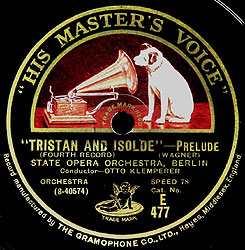
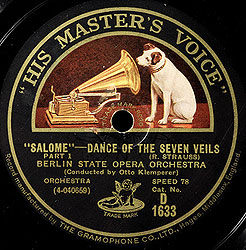 Rather than try to reconcile these seemingly incompatible extremes, Kurakin asserts that contradiction was a basic ingredient of Klemperer's character, both as man and musician, and that the equilibrium of conducting ultimately afforded an outlet for his painful extremes and deepened his musical responses. These overtures preserve a taste of all three perspectives, even if Chevalley found the last to dominate at this stage. The Brahms revels in speed (clocking in about two minutes faster than the "objective" Toscanini account) and seems more rushed than celebratory (and yet issued on three sides with a Mozart Divertimento Minuet filler led by Blech, thus defeating any suspicion that the pace was mandated by necessity). The Mendelssohn sticks with traditional tempos but applies extreme dynamics that forfeit much of the inherent grace by burying the enchanting "fairy music" melody beneath its accompaniment during each of its four appearances. The Weber receives a solid reading with smooth transitions, largely resisting temptation to run away at the end.
Rather than try to reconcile these seemingly incompatible extremes, Kurakin asserts that contradiction was a basic ingredient of Klemperer's character, both as man and musician, and that the equilibrium of conducting ultimately afforded an outlet for his painful extremes and deepened his musical responses. These overtures preserve a taste of all three perspectives, even if Chevalley found the last to dominate at this stage. The Brahms revels in speed (clocking in about two minutes faster than the "objective" Toscanini account) and seems more rushed than celebratory (and yet issued on three sides with a Mozart Divertimento Minuet filler led by Blech, thus defeating any suspicion that the pace was mandated by necessity). The Mendelssohn sticks with traditional tempos but applies extreme dynamics that forfeit much of the inherent grace by burying the enchanting "fairy music" melody beneath its accompaniment during each of its four appearances. The Weber receives a solid reading with smooth transitions, largely resisting temptation to run away at the end.
Strauss: Don Juan, Till Eulenspiegel's Merry Pranks, Salome: Dance of the Seven Veils ~ Beginning in 1916 with the composer's own recordings (although George Szell is rumored to have led the first half of Don Juan), few conductors and record producers have been able to resist these two tone poems (indeed, Henry Wood and "His Orchestra" launched the competition with a cut version of Till on Columbia that same year) and with good reason – they're light, melodious, segmented and brilliantly orchestrated – and each fit comfortably on two double-sided 78 rpm 12" discs. Indeed, the works are so appealing and exemplary that interpretation seems unwarranted and little can be said to distinguish their legions of recorded renditions. Klemperer's are sharp and wonderfully expressive, but so are nearly all the others. (The precision may have arisen from four separate sessions devoted to waxing the total of eight sides, an extreme luxury at the time.) Salome was one of the Kroll's star productions and the music of its Dance of the Seven Veils, even when heard in isolation from the depravity of the accompanying stage action, is a brilliant blend of sublimated craving and untamed ferocity which Klemperer fully unleashes, especially when compared to the more sensuous but reserved 1929 Stokowski/Philadelphia Victor version.
Wagner: Siegfried Idyll; Tristan und Isolde: Act I Prelude ~ As with his entire generation (and many since), Klemperer was enthralled and guided by the impact of Wagner's fulfillment of the promise of Romanticism, and led Wagner's operas early and often, and mostly to great acclaim, beginning with Lohengrin in 1910 at age 25 and tackling his first complete Ring at age 26. The others all followed, with Tristan in 1913, of which the famed prelude became his first Wagner recording, in which the long buildup to the climax is handled with great care, and to which is added the tail of the Liebestod. Klemperer claimed to feel quite strongly that the Siegfried Idyll should be played only in its original chamber setting for 13 instruments and even resigned as guest conductor of the New York City Orchestra in 1941 when the director insisted that it be presented with full strings, as is usually done. Yet his two recordings – here and a 1961 stereo remake – are with ensembles that possibly were reduced, but audibly larger than Klemperer's ostensible line in the sand. In any event, his recording is sufficiently tender but rises to levels of great visceral excitement when fitting. The most "authoritative" contemporaneous account, two minutes faster and more straightforward, was made by the London Symphony (HMV, 1927) led by none other than Siegfried Wagner, for whose birth the piece had been written and who grew into a respected interpreter of his father's music and keeper of the proverbial flame.
Brahms: Symphony # 1~ Critical reaction to a 1928 Klemperer concert of the Brahms First suggests how such judgments are wildly subjective and unreliable guidance: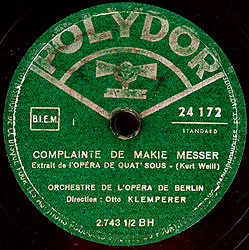
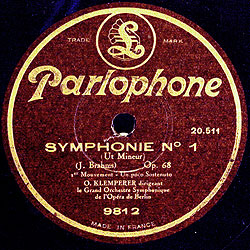 as documented by Heyworth, two critics "both commented on a lack of pathos, the former with approval, the latter with reservations. Similarly, while [a third] criticized a lack of romantic lyricism, [a fourth] singled out that very quality for praise as heralding a new world of feeling." Fortunately, we have Klemperer's recording made three weeks later upon which to base our own assessment, as well as several contemporaneous recordings by others known for their own distinctive styles to which it fruitfully can be compared. More than any other conductor (including Toscanini) Felix Weingartner ushered in our modern predilection for moderation and austerity and his 1924 Brahms First with the London Symphony on Columbia, while far from mechanical, begins with propulsive momentum which he largely retains with far less tempo variation than in others' renditions; as a result, when he occasionally does relent the impact is magnified. At the other end of the interpretive scale, a 1923 Staatskapelle recording on Polydor with Oskar Fried, with whom Klemperer worked, displays hugely elastic phrasing to underscore the structure of the outer movements, including startling gear shifts in the finale. In the first electrical recording of the Brahms First, Hermann Abendroth and the London Symphony on HMV in 1926 are somewhat more moderately paced but still quite free, especially in the finale. A 1927 set from the Philadelphia Orchestra under Leopold Stokowski takes comparable liberties, although he fell entirely outside German tradition. The Klemperer falls somewhere between these extremes, moderate but engaged. Far from the rigid indifference cited by critics of the time, it serves to display the vast gulf between their standards (in which personal inflection was expected) and our modern one (which commends strict adherence to the score).
as documented by Heyworth, two critics "both commented on a lack of pathos, the former with approval, the latter with reservations. Similarly, while [a third] criticized a lack of romantic lyricism, [a fourth] singled out that very quality for praise as heralding a new world of feeling." Fortunately, we have Klemperer's recording made three weeks later upon which to base our own assessment, as well as several contemporaneous recordings by others known for their own distinctive styles to which it fruitfully can be compared. More than any other conductor (including Toscanini) Felix Weingartner ushered in our modern predilection for moderation and austerity and his 1924 Brahms First with the London Symphony on Columbia, while far from mechanical, begins with propulsive momentum which he largely retains with far less tempo variation than in others' renditions; as a result, when he occasionally does relent the impact is magnified. At the other end of the interpretive scale, a 1923 Staatskapelle recording on Polydor with Oskar Fried, with whom Klemperer worked, displays hugely elastic phrasing to underscore the structure of the outer movements, including startling gear shifts in the finale. In the first electrical recording of the Brahms First, Hermann Abendroth and the London Symphony on HMV in 1926 are somewhat more moderately paced but still quite free, especially in the finale. A 1927 set from the Philadelphia Orchestra under Leopold Stokowski takes comparable liberties, although he fell entirely outside German tradition. The Klemperer falls somewhere between these extremes, moderate but engaged. Far from the rigid indifference cited by critics of the time, it serves to display the vast gulf between their standards (in which personal inflection was expected) and our modern one (which commends strict adherence to the score).
Weill: Kleine Dreigroschenmusik ~ Although seemingly among the least of Klemperer's Kroll-era recordings, the Weill boasts the greatest historical significance as his only recording of a contemporary work. Although he never mounted it at the Kroll, Klemperer became so enthralled by Weill's bitterly satiric 1928 Three-Penny Opera that he attended many performances and then commissioned a suite from its composer, which he programmed often. His last Parlophone recording (of Don Juan) had been in 1929, but then he returned to Polydor in 1931 to wax four of the seven numbers from the suite ("Die Moritat von Mackie Messer," "Die Ballade vom angenehmen Leben," "Tango-Ballade" and "Kanonensong"), scored for flutes, clarinets, saxophones, bassoons, trumpets, trombone, tuba, banjo, percussion and piano to emulate the pit band of the original show. Weill disparaged this (his own!) and other arrangements as "industrialized" but Klemperer's alternately wry and raucous sides hold their own with the only "authentic" versions Weill claimed to admire – a 1929 Odeon record of the "Cannon Song" and "Tango Ballad" by the original production's Lewis-Ruth band led by its conductor Theo Mackeben, who also cut a 1930 Audiophon-Electro disc of the same songs plus the famous "Moritat" (better known now in its sanitized English version as "Mack the Knife"). They also compare well with the "original cast" recording (although it was made two years later and used several substitute singers) on Ultraphon, also with the Lewis-Ruth band led by Mackeben. Klemperer's Weill discs have vastly more spirit than his 1961 EMI stereo remake of the entire suite with the Philharmonia and in any event must serve as our only souvenir of his avant-garde captaincy of the Kroll and his contribution to the cause of modern German music before reactionary forces took over and his own views veered toward tradition.
After the 1931 Weill session Klemperer would not enter a recording studio again for 15 years. Fortunately, numerous concerts have been preserved to fill the void.
Following the closure of the Kroll Theater, Klemperer's contract was assumed by the State Opera, but modified to direct specific projects rather than the full authority to which he had been entitled (and for which he unsuccessfully sued to enforce).
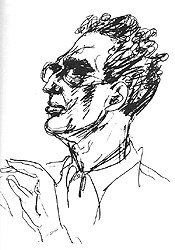 Klemperer in 1932, by B. F. Dolbin |
Fortunately, despite his absence from the studio, we have recordings of substantial portions of five broadcast concerts Klemperer gave with the Los Angeles Philharmonic during this period. As issued on CD by the German Archiphon label in direct transfers from the original acetates, the sonics are mediocre and mostly muffled, with crunchy surfaces, gouges and occasional continuity gaps (and even groove skips), all of which preclude any meaningful attempt to assess textures, balances, dynamics or other subtleties beyond basic tempos. Yet collectively they afford our first glimpses of Klemperer both in concert and away from his homeland.
Verdi: I vespri siciliani Overture; Beethoven: Symphony # 5; Wagner: Die Meistersinger Overture ~ According to the announcer, this 1934 New Year's Day concert introduced "the distinguished German conductor" to the radio audience and a fine introduction it was. It begins with our only recording of his Verdi, several of whose operas and Requiem he led – suitably turbulent and expressive – and proceeds through a solid but propulsive and strongly-accented Beethoven Fifth that includes the first and last movement repeats and a surprisingly rousing acceleration � la Furtw�ngler for the final coda. The concert concludes with the Meistersinger Overture, smoothly-blended but with well-characterized sections. Ensemble is taut (until it begins to unravel at the very end), thus suggesting ample preparation and a fertile bond between the orchestra and its new conductor despite the freshness of their association.
Critical reaction to a New York Beethoven concert later that year helps to place Klemperer's work of the time in context.
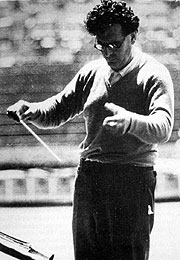 Rehearsal, Los Angeles, 1936 |
Schoenberg: arrangement of Brahms Piano Quartet # 1 in G-minor, Op. 25; Concerto for String Quartet and Orchestra [after Handel's Concerto Grosso, Op. 6 # 7] ~ Arnold Schoenberg claimed to love the Brahms piano quartet, but with strong reservations: "It is always very badly played, because the better the pianist the louder he plays and you hear nothing from the strings. I wanted to hear everything." Frankly, that problem eludes me in either of two classic renditions (Rudolf Serkin and the Busch Quartet, 1949; Emil Giles and the Amadeus Quartet, 1971) but who am I to argue? Schoenberg's transcription respects the original structure but exploits the textural resources of a full orchestra, including a battery of percussion – and no piano. Klemperer acclaimed the result as "a revelation" and gave the world premiere in a January 1938 concert. It's a hugely dynamic reading and lots of fun with a raucous Gypsy rondo finale but the recording obscures much detail and is soured with considerable wow. The 1933 concerto after Handel is an altogether different matter. Schoenberg had a lower opinion of the Handel original than of the Brahms quartet, seeking to replace perceived defects of repetition, sequencing and insufficient use of the themes with "real substance." The result is more a fantasy inspired by Handel than a transcription. While the opening largo is relatively unscathed, Handel gets progressively left in the dust, with radical reworking of his basic structure, rhythms, dynamics, harmony and textures, amid abundant dissonance and outbursts. To the extent that Klemperer's direction can be discerned from the especially poor recording, the mere fact of programming and realizing it seems at least as impressive as any interpretive consideration.
Gershwin: Prelude # 2 ~ An intriguing appendage is this rare recorded Klemperer performance of a current (yet hardly progressive) work. Klemperer considered Gershwin arrogant but gifted ("full of invention, the strongest trait that can be given to a composer"). On September 8, 1937 a memorial concert was held in the Hollywood Bowl. Klemperer opened it with an orchestral arrangement of Gershwin's second prelude that turns the graceful, pensive piano piece into a lumbering dirge, although perhaps appropriately so, given the occasion. Attribution of the arrangement is unclear:
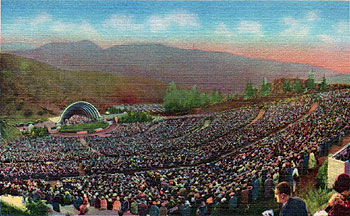 The mammoth Hollywood Bowl (from a post card) |
Wagner: Rienzi Overture; Albeniz: Triana; various opera arias and songs ~ Speaking of populism, as part of his duties in Los Angeles Klemperer was a good sport and led lighter programs at the Hollywood Bowl, including this June 6, 1937 concert. If the Albeniz seems earthbound, the Wagner overture wraps up in a frenzy and the vocal accompaniments for soprano Lucrezia Bori (including excerpts from La Boheme) reflect the same care he lavished on more weighty fare.
Berlioz: Benvenuto Cellini Overture; Debussy: Prelude to the Afternoon of a Faun; Mozart: Symphony # 35 ("Haffner"); Strauss: Till Eulenspiegel ~ A big surprise here, afforded by comparison with Klemperer's 78s: Debussy's Faun emerges as animated and expressionist rather than the sober restraint of his Kroll-era Nocturnes and a far cry from accustomed sensual or diffident presentations. The rest of this January 1, 1938 New Year's broadcast is much as expected – the Berlioz effectively underlines the essence of each episode (aside from some rough horn playing that is cruelly exposed by the recorded balance) the thick texture of our first Klemperer Mozart symphony is offset by brisk tempos, and Till is comparably expressive with the Kroll version.
Bruckner: Symphony # 9 (New York Philharmonic, September 14, 1934) ~ The biggest surprise of this period comes from the only concert preserved from outside Los Angeles. As proudly announced beforehand, this was the American debut of the original score of the Bruckner Ninth rather than the 1903 L�we alteration which smoothed over its rough edges. As though to differentiate it from that milder version, Klemperer throws caution to the winds with a reading of astonishing visceral impact, approaching much of the shattering tortured anguish of Furtw�ngler's astounding 1943 Berlin Philharmonic recording while largely attempting to meld Bruckner's disparate fragments rather than force them to abrade in brazen conflict. The Ninth is unique in Bruckner's entire output, leaping into uncharted territory that his Eighth and other prior works only approached. Klemperer's rendition is unique as well, standing far apart from his acoustical 78s of the Eighth Adagio and channeling a level of raw emotion that would rarely reappear in the rest of his career on records. Unfortunately, the recording alters the balance by burying Bruckner's all-important brass beneath the strings, but enough is left from which to infer the extraordinary power of this reading.
The next years derailed and even threatened to end Klemperer's career as his conduct slid into disrepute while he was recovering from his brain tumor and the crippling operations that followed. As detailed by Heyworth, he had a wild appearance, dressed haggardly, stormed out of rehearsals in a rage, waved water pistols, caroused at night trying to pick up stray women, took a mistress and sent her bills to his wife, begged and squandered money, refused to pay for taxis he routinely ordered, sent scathing letters and threatened lawsuits. 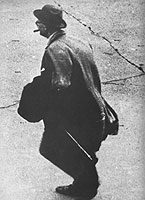 His reputation hit a nadir when he was arrested and placed in protective custody after an eight-state all-points police bulletin warned that he was "insane and dangerous" after escaping from a sanitarium. Although he had become a social and professional outcast and his Los Angeles Philharmonic contract was cancelled, sporadic professional appearances continued from which we have partial recordings. From fragments of early 1941 Los Angeles concerts the Menuetto of the Mozart Symphony # 40 (January 22) is briskly paced with a faster da capo and the finale derives its force through strong dynamic demarcation. Disjointed segments of a February 11 Beethoven Fifth are barely distinguishable from the 1934 concert, although the coda of its finale lacks the former acceleration. These crumbs barely suggest a major impact upon Klemperer's interpretive outlook despite the radical decay of his personal bearing.
His reputation hit a nadir when he was arrested and placed in protective custody after an eight-state all-points police bulletin warned that he was "insane and dangerous" after escaping from a sanitarium. Although he had become a social and professional outcast and his Los Angeles Philharmonic contract was cancelled, sporadic professional appearances continued from which we have partial recordings. From fragments of early 1941 Los Angeles concerts the Menuetto of the Mozart Symphony # 40 (January 22) is briskly paced with a faster da capo and the finale derives its force through strong dynamic demarcation. Disjointed segments of a February 11 Beethoven Fifth are barely distinguishable from the 1934 concert, although the coda of its finale lacks the former acceleration. These crumbs barely suggest a major impact upon Klemperer's interpretive outlook despite the radical decay of his personal bearing.
We have nothing further for four years as Klemperer struggled to emerge from this grim patch, and then a final pair of 1945 Los Angeles Philharmonic "Standard Hour" broadcasts. On January 11 he led a thoroughly delightful Thomas Mignon Overture, a spirited, lilting and crisply articulated Strauss Fledermaus Overture, a deeply peaceful Bach Bist du bie mir and a Liszt Totentanz tightly synchronized with Brazilian-American pianist Bernardo Segall to highlight its disparate episodes with full energy and focus, but concluding with a Dvorak "New World" Symphony with rough ensemble and considerably less definition. A December 16 program presents a Beethoven Third Leonore Overture and a Strauss Don Juan that both sound somewhat flat compared to his earlier 78s, emerging more as absolute music than reflecting the dramas they depict. (The concert also had a mellow Bach "Air on the G String" and a dreary Corelli "La folia" violin sonata arranged for orchestra that affords our first glimpse of Klemperer as accompanist, here with Josef Szigeti, whose cadences he supports quite closely, but from which little can be gleaned, as its only animation arises in the solo cadenza.) While it's unfair to generalize from just two concerts it's still tempting to attribute the disparity among and within them to the impact of Klemperer's wavering mental state.
In 1946 Klemperer departed for Europe, ostensibly to seek to heal the wounds of war through music but as likely to seek more welcoming territory on which to rebuild his career. In Budapest he found a new home and returned to his first love as a conductor of opera. 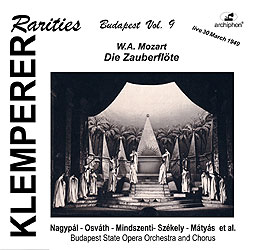 He considered his three years there among the happiest of his life, with excellent orchestras, wonderful singers, receptive audiences and a theatre director, Aladar Toth, who tolerated his abusive behavior and fully supported him even after the Soviet takeover (which Klemperer at first na�vely credited with a desire for peace, but ultimately he would be repelled and driven away by their cultural demands for populist realism). Klemperer did bridle against the insistence of singing in Hungarian translation, which he considered "very stupid" but managed to abide. (While the resulting texts sound strange and I can't vouch for their propriety, the syllables do manage to fit comfortably into the music.) The public was enthused, with critics' reservations limited to Klemperer's fast tempos and insistence on personally accompanying recitatives on a piano even though his stroke limited him to the use of one hand. As with his Los Angeles stint, to fill in this further gap in Klemperer's studio discography fortunately we have recordings of several concerts in Budapest with the Hungarian Radio Symphony Orchestra as well as a half-dozen complete operas with the Hungarian State Opera and Chorus (Lohengrin, Meistersingers, Tales of Hoffmann, Cos�, Zauberfl�te and Fidelio) plus excerpts from Don Giovanni; all are given attentive, spirited readings, but I'll stick with the one that I know best:
He considered his three years there among the happiest of his life, with excellent orchestras, wonderful singers, receptive audiences and a theatre director, Aladar Toth, who tolerated his abusive behavior and fully supported him even after the Soviet takeover (which Klemperer at first na�vely credited with a desire for peace, but ultimately he would be repelled and driven away by their cultural demands for populist realism). Klemperer did bridle against the insistence of singing in Hungarian translation, which he considered "very stupid" but managed to abide. (While the resulting texts sound strange and I can't vouch for their propriety, the syllables do manage to fit comfortably into the music.) The public was enthused, with critics' reservations limited to Klemperer's fast tempos and insistence on personally accompanying recitatives on a piano even though his stroke limited him to the use of one hand. As with his Los Angeles stint, to fill in this further gap in Klemperer's studio discography fortunately we have recordings of several concerts in Budapest with the Hungarian Radio Symphony Orchestra as well as a half-dozen complete operas with the Hungarian State Opera and Chorus (Lohengrin, Meistersingers, Tales of Hoffmann, Cos�, Zauberfl�te and Fidelio) plus excerpts from Don Giovanni; all are given attentive, spirited readings, but I'll stick with the one that I know best:
Beethoven: Fidelio ~ Klemperer had been conducting Beethoven's only opera since 1912, when he had a scandalous affair with soprano Elizabeth Schumann, was beaten by her husband and was fired from his position. 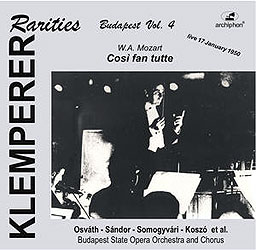 Fidelio was his first production to open the Kroll, where it raised great expectations; Klemperer was both praised for his precision while at the same time condemned for ostensibly draining the opera of its overriding theme of personal freedom by imposing tyrannical control over the staging. (The traditional critics' resistance wasn't helped by highly-stylized cubist sets.) Klemperer came to develop some deeply personal and perhaps idiosyncratic ideas about the various numbers – in his view, the musical climax lies in the first-act quartet, the following trio is heroic, Pizarro is Satan incarnate for whom the orchestra "shrieks, rages, roars," and the introduction to the prisoners' chorus is "an orchestral miracle." He also had high praise for the oft-deprecated libretto which he felt had been written to be set to Beethoven's music.
Fidelio was his first production to open the Kroll, where it raised great expectations; Klemperer was both praised for his precision while at the same time condemned for ostensibly draining the opera of its overriding theme of personal freedom by imposing tyrannical control over the staging. (The traditional critics' resistance wasn't helped by highly-stylized cubist sets.) Klemperer came to develop some deeply personal and perhaps idiosyncratic ideas about the various numbers – in his view, the musical climax lies in the first-act quartet, the following trio is heroic, Pizarro is Satan incarnate for whom the orchestra "shrieks, rages, roars," and the introduction to the prisoners' chorus is "an orchestral miracle." He also had high praise for the oft-deprecated libretto which he felt had been written to be set to Beethoven's music.
Klemperer's 1962 studio Fidelio is universally acclaimed for not only its splendid cast but Klemperer's monumental conception, its nobility and dignity fitting the overarching themes and its monolithic outlook providing a sense of moral continuity to unify what admittedly is a disjointed composition with a far-fetched plot. This November 8, 1948 Budapest performance is its diametric opposite – a galvanic manifesto surging with righteous indignation, its Olympian themes brought down to an intensely mortal level. Nearly all the tempos are about 20% faster than they would be in 1962, lending a sense of constant fervor and urgency that becomes exhausting. From the very outset, the opening phrase of the overture explodes with a demand for attention, the opening duet bursts with the ardor of youth, and the sheer passion never relents – Pizarro's march rushes by like silent slapstick, Anna B�thy as Leonore and Endre R�sler as Florestan tear their hearts out in their arias, the prisoner chorus leaves no room to doubt the urgency of freedom, the rush to the climactic trumpet call is frenetic and the finale accelerates to a barely coherent orgiastic jumble, but if the bold and assertive singing has little subtlety it only serves to accentuate the underlying ardor. Sonic fidelity is decent even if the predominance of the voices occasionally pushes the orchestra too far into the background. Yet when it does emerge, as when tympani punctuate Pizarro's aria, the effect is electrifying. I can't gauge the aptness of the Hungarian translation but the syllables do seem to fit even if the absence of familiar key phrases ("Abscheulicher!" "Ein stoss" "Gott! Welch Dunkel hier!") can rattle accustomed ears. 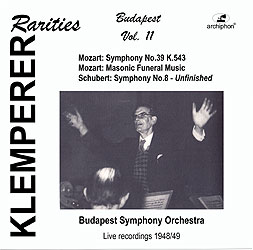 Other than the melodrama, dialogue is omitted from the recording but for those not fluent in Hungarian the loss is trifling. In an article preceding his Budapest Fidelio Klemperer characterized the third Leonore Overture as an expressly concert composition and justified omitting it here between the scenes of Act II where it often is heard.
Other than the melodrama, dialogue is omitted from the recording but for those not fluent in Hungarian the loss is trifling. In an article preceding his Budapest Fidelio Klemperer characterized the third Leonore Overture as an expressly concert composition and justified omitting it here between the scenes of Act II where it often is heard.
In my previous article I had hailed Bruno Walter's 1941 Metropolitan Opera Fidelio as the most viscerally gripping and inspired on record, but I now would rank Klemperer's Budapest performance as a very close second.
Wagner: Lohengrin ~ This October 24, 1948 recording preserves a revelatory incident, as a demonstrative ovation follows Magda Rig�'s Narrative of the Grail ("In fernem Land") in the midst of the final scene. At first unfazed, Klemperer continues to conduct through the brief succeeding chorus but then stops the music, has verbal exchanges with the audience, shouts "Frechheit" (impudence), walks off the podium, is urged to return and resumes nearly two minutes later. The next day he published an article in which he regretted the incident but explained that in previous performances, "the applause soon ceased but yesterday it did not, [so] not a single sound from either the chorus or the orchestra could be heard. � I tried repeatedly to signal to the audience asking them to stop, but to no avail. � The endless applause drowned everything. � I am not in the least opposed to approval being expressed in opera where the arias can be repeated [but] one cannot possibly give an encore of any piece of a Wagner opera, since the orchestra continues to play on immediately and there is no question of set pieces or arias in these operas at all. � I consider it as an improper custom in bad taste. � I have always tried to avoid bad taste in music." Thus did Klemperer insist upon his view of musical integrity even at the expense of alienating an audience, which, according to the article, on that night repaid him by greeting his appearance at the final curtain with "shouts of fie, hisses and whistles."
Bach: Orchestral Suite # 2, Brandenburg Concerti 4 and 5, Magnificat ~ In Los Angeles Klemperer had proposed Bach with harpsichords, original instruments, baroque bows and choirs of boys rather than women, but his plan was too far ahead of its time and was never realized.
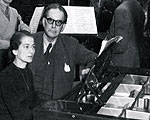 With Annie Fischer |
Mozart: Symphony # 39, Masonic Funeral Music; Schubert: Symphony # 8 ("Unfinished") ~ The symphony is fine bracing Mozart – brisk but not harshly driven,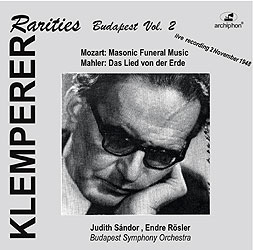 structures crafted by bold dynamics rather than tempo changes (although the Andante is somewhat pliant), vibrantly played with excellent ensemble (evidencing a combination of a strong orchestra, sufficient rehearsal and devotion to the conductor) and all repeats taken (a luxury rarely encountered in 78-era studio recordings where timing was at a premium, as opposed to in concerts). The Schubert, too, unfolds swiftly but with somewhat greater tempo variation and smooth transitions between outbursts, more muscular than tender. The Funeral Music flies by in barely four minutes with intense emphases, more defiant than brooding or grief-stricken.
structures crafted by bold dynamics rather than tempo changes (although the Andante is somewhat pliant), vibrantly played with excellent ensemble (evidencing a combination of a strong orchestra, sufficient rehearsal and devotion to the conductor) and all repeats taken (a luxury rarely encountered in 78-era studio recordings where timing was at a premium, as opposed to in concerts). The Schubert, too, unfolds swiftly but with somewhat greater tempo variation and smooth transitions between outbursts, more muscular than tender. The Funeral Music flies by in barely four minutes with intense emphases, more defiant than brooding or grief-stricken.
Mahler: Das Lied von der Erde ~ This is our first taste of Klemperer's Mahler, whose affection stemmed in part from Klemperer's resemblance to his own younger brother Otto, who had killed himself. Klemperer met with Mahler several times, attended many of his rehearsals and had his own conducting career launched with a testimonial Mahler provided. While Klemperer considered Das Lied to have been Mahler's farewell to life, in a 1948 radio address he contended that Mahler was fundamentally lively and cheerful and (perhaps intending a pun) insisted that it was "a grave mistake to regard Mahler as a world-weary man." Here he dispatches the whole thing in under 51 minutes (vs. 64 in his 1964 studio recording) mostly due to exceptionally fleet outer movements, minimizing the introspection of the first (spurred by tenor Endre R�sler's urgent excitement) and the sheer resignation of the ending (somewhat compromised by contralto Judit S�ndor's wide, wobbly vibrato). Klemperer considered the primary trait that made Mahler a remarkable conductor to have been the justness of his tempos – "One felt that it could not be otherwise" – but recalled Mahler telling him that tradition was slovenliness and that there should be none for his works. He further was told by Mahler during rehearsals of his Symphony # 8: "If, after my death, something doesn't sound right, then change it. You have not only the right but the duty to do so." So perhaps after all is said and done, Mahler himself might have approved, if not welcomed, this radically different take on a work which so often dwells in ineffable sadness.
Embarking for Europe after a decade in America, Klemperer returned to the recording studio for the first time in 15 years. A year earlier George Mendelssohn-Bartholdy had started Vox as an independent label that initially licensed European masters for US release but sought to expand into original productions, just as Klemperer needed a vehicle to rebuild his career. In part to save costs, for their first project an ad hoc "Pro Musica Orchestra" was assembled in Paris to record all six Bach Brandenburg Concertos and the Mozart Eine Kleine Nachtmusik during a single highly productive week in July 1946. Each concerto was issued in a separate album of two or three 12" 78s (with short Bach fillers for the final sides of #s 1 and 3) but apparently had weak distribution (on Polydor in France and Vox in the US) and disappointing sales, and so the arrangement lapsed until early 1950, even though Klemperer's contract had anticipated four sessions per year. (Although either party was able to terminate upon notice, it was an exclusive contract, which perhaps explains why Klemperer made no recordings in the interim.) In February 1950 a further Paris session with the Pro Musica yielded the Mozart Symphonies 25 and 36 ("Linz"), followed in November with the Schubert Symphony # 4 credited to the Lamoureux Orchestra (leading to speculation that the Pro Musica had been drawn from it). By then LP sales had taken off and the Klemperer/Vox collaboration shifted into high hear with the Vienna Symphony Orchestra (an outfit reconstituted after WWII and not to be confused with the venerable Vienna Philharmonic). The Beethoven Missa Solemnis and "Pastoral" Symphony and Bruckner Symphony # 4 all were dispatched in five days and by June four more symphonies, three piano concertos and Mahler's Das Lied von der Erde followed and received wide distribution throughout Europe and even Australia and Japan. The arrangement ruptured for good when Klemperer had time to record only the first two movements of Mendelssohn's Symphony # 3 ("Scottish") before embarking on a concert tour; it was completed by the obscure Herbert Haefner and then released under Klemperer's name without his consent.
Bach: Brandenburg Concertos; Mozart: Eine Kleine Nachtmusik ~ Remarkably, this was only the third set of Brandenburgs on record and thus a hugely bold venture at a time before their huge current popularity. Although individual concerti had been recorded earlier, the first full set had been issued in 1929 by pianist/conductor/scholar Alfred Cortot and his Orchestre de l'�cole Normale de Musique, Paris, and a second in 1935 by famed violinist Adolph Busch and his newly-formed Busch Chamber Players. 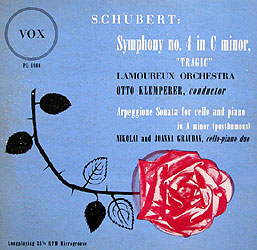
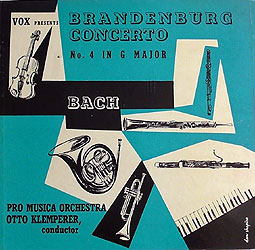 Their approaches could not have been further apart and established the extremes of Bach interpretation – the Cortot bursts with headstrong interpretation, exploration and raw vitality that leaves an overall impression of constant discovery, while the Busch, although warm and spiritual, is free of Romantic impulse and presents the music with utmost respect for the integrity of Bach. Klemperer leans more toward Busch's approach. He had directed the first Brandenburg in 1921 using solo instruments and the sixth in 1929, attracting praise for his balances and historical validity but objections to metronomic tempos, restricted dynamics and an overall lack of emotion. In a 1942 article, noting the rarity of expression marks and dynamics in Bach's actual manuscripts, he had chided performers who felt compelled to "fill in the vacuum" and urged interpretive restraint. His Vox set is embedded in a dry acoustic that produces clarity without a need for overly crisp articulation, with few Baroque embellishments other than occasional trills. Balances among winds and strings are carefully judged and phrases are nicely shaped with dynamics gently rising and falling except when stronger contrasts seem apt. Other than slight slowing at movement ends, tempos are steady and range from peppy to somewhat dreary, but the playing itself is far from rigid (and occasional imprecisions not only suggest a degree of freedom but perhaps hint that the group was hastily assembled without time to cohere, rehearsed inadequately and/or had little time for retakes, all understandable in light of the intensive schedule and tight economics). Pianos had been used for the lengthy cadenza in the fifth concerto both by Cortot (played by himself) and Busch (by Rudolph Serkin), but Klemperer adds authenticity with a harpsichord (although the dull recording makes it sound more like a clavichord). Bach had written "Adagio" and a two-note cadence between double-bars separating the two movements of the third concerto, thus suggesting to scholars the need for an improvisation; Klemperer sidesteps the issue of what to insert by doing nothing at all, although the absence of a bridge was less conspicuous on the 78s, when an artificial pause would have resulted from having to change records at that point. Overall, Klemperer's Brandenburgs serve as a prognostic steppingstone to the historically-informed performances to which we've now become accustomed but which would begin to emerge only incrementally over the succeeding decades. The modest Mozart serenade, too, is graced with a fine unaffected performance that takes its place with the best of them (and, like the Brandenburgs, there are many!).
Their approaches could not have been further apart and established the extremes of Bach interpretation – the Cortot bursts with headstrong interpretation, exploration and raw vitality that leaves an overall impression of constant discovery, while the Busch, although warm and spiritual, is free of Romantic impulse and presents the music with utmost respect for the integrity of Bach. Klemperer leans more toward Busch's approach. He had directed the first Brandenburg in 1921 using solo instruments and the sixth in 1929, attracting praise for his balances and historical validity but objections to metronomic tempos, restricted dynamics and an overall lack of emotion. In a 1942 article, noting the rarity of expression marks and dynamics in Bach's actual manuscripts, he had chided performers who felt compelled to "fill in the vacuum" and urged interpretive restraint. His Vox set is embedded in a dry acoustic that produces clarity without a need for overly crisp articulation, with few Baroque embellishments other than occasional trills. Balances among winds and strings are carefully judged and phrases are nicely shaped with dynamics gently rising and falling except when stronger contrasts seem apt. Other than slight slowing at movement ends, tempos are steady and range from peppy to somewhat dreary, but the playing itself is far from rigid (and occasional imprecisions not only suggest a degree of freedom but perhaps hint that the group was hastily assembled without time to cohere, rehearsed inadequately and/or had little time for retakes, all understandable in light of the intensive schedule and tight economics). Pianos had been used for the lengthy cadenza in the fifth concerto both by Cortot (played by himself) and Busch (by Rudolph Serkin), but Klemperer adds authenticity with a harpsichord (although the dull recording makes it sound more like a clavichord). Bach had written "Adagio" and a two-note cadence between double-bars separating the two movements of the third concerto, thus suggesting to scholars the need for an improvisation; Klemperer sidesteps the issue of what to insert by doing nothing at all, although the absence of a bridge was less conspicuous on the 78s, when an artificial pause would have resulted from having to change records at that point. Overall, Klemperer's Brandenburgs serve as a prognostic steppingstone to the historically-informed performances to which we've now become accustomed but which would begin to emerge only incrementally over the succeeding decades. The modest Mozart serenade, too, is graced with a fine unaffected performance that takes its place with the best of them (and, like the Brandenburgs, there are many!).
Mozart: Symphonies 25 and 36 ("Linz") ~ Klemperer may have been in the forefront of updating Bach's image from the academic relic of yore but he had plenty of company in shaking off the perception of Mozart as a shallow rococo trifle. Even so his Mozart readings are distinctive and, like his Bach, paves the way toward the modern trend of period authenticity. Even aside from the singular accounts of other Mozart symphonies by Strauss, Toscanini, Coates, Weingartner and others, for # 25 he was preceded by Alfred Wallenstein and his Sinfonietta (1938 – propulsive and rather curt), John Barbirolli and the New York Philharmonic (1943 – sharp-edged, and squeezed onto four sides by omitting all repeats) and Sergiu Celibidache and the London Philharmonic (1948 – patient, weighty and serious, with an air of mystery and expectation). Klemperer's Pro Musica set has strong dynamics, better balance and more pliancy without sacrificing its essential energetic drive. For the Linz, collectors could choose among Fritz Busch and the BBC Symphony (1934 – brisk and sharp), Thomas Beecham and the London Philharmonic (1938 – patient and affectionate) and several lesser-knowns. Klemperer, by contrast, treads a moderate middle path with crisp rhythm yet attention to detail.
Schubert: Symphony # 4 ~ Whether a predilection for neglected repertoire or a shrewd marketing decision (or both), Klemperer's final session of 1950 was another bold choice: far from popular at the time, and with only a single prior decade-old recording (Barbirolli/New York Philharmonic, 1939), the Fourth was Schubert's earliest symphony in a minor key and known as the "Tragic" although he was still in his teens and it hardly comprised the wellspring of deep emotion the title might imply. Yet it did reflect a new maturity from his prior three symphonies that had been influenced by Haydn, as here Beethoven's impact begins to be felt in the brooding introduction, weighty outer movements, earthy Minuet and a tense episode with a sudden key shift that intrudes into the Andante. Klemperer's reading is properly poised between boyish vitality and emerging wisdom, giving youth its full due while injecting enough heft to signal the great works that lay ahead in the remaining decade of Schubert's life. While the Mozart symphonies were issued individually in France on 78s and coupled on LP for the US, the Schubert was issued only on LP for worldwide distribution (as were all subsequent Klemperer Vox recordings).
Beethoven: Symphony # 6 ("Pastoral"), Missa Solemnis; Bruckner: Symphony # 4 ~ A week in March 1951 brought Klemperer's first collaboration with the Vienna Symphony Orchestra, and it was to prove a decidedly mixed bag. 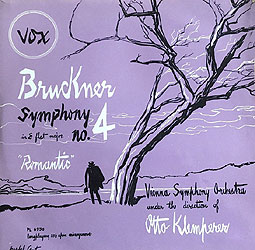
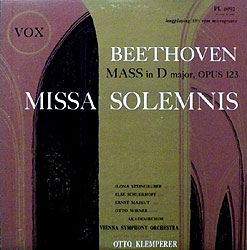 Perhaps the Pastoral was tackled first, before conductor and orchestra became familiar, or last when they were exhausted, but whatever the reason the playing is neither polished nor enthused (and indeed downright sloppy in spots) and exhibits some mighty weird balances that perhaps can be credited as highlighting some overlooked aspects of the score but all too often seem random and unintended and serve to compromise Klemperer's fundamentally tender vision. While technically a harder piece to perform, the Bruckner recording has few of these lapses. The central Adagio is accurate, smooth and sustained with potent impact when Klemperer accelerates for the climax, while the scherzo surrounds an especially relaxed trio. Only in the finale does the focus become diffuse. Most remarkable, though, is a sense of constant urgency often missing in Bruckner – indeed, among the hundreds of studio and concert performances compiled by the Bruckner Society of America, at 51 minutes it's by far the fastest Bruckner Fourth on record; by comparison, the only two prior recordings (Bohm/Saxon State, 1936; Jochum/Hamburg, 1939) clock in at a far more conventional 63 minutes (and rather than fitting on a single Vox LP they each required a bulky set of eight 78s). Klemperer's remarkably tight reading is Bruckner for people who hate Bruckner (or at least the sheer length of his symphonic conceptions). Klemperer's Missa Solemnis, too, is remarkably swift – its 72 minutes would not be matched until the emergence of historically-informed readings a generation later and its only former recordings (Kittel/Berlin, 1928 – 85 minutes; Koussevitzky/Boston, 1938 – 83 minutes) were far more typically-paced and required a cumbersome (and expensive) twelve 78s. Initially released as a double-disc boxed set, the Klemperer was reissued in 1959 with over 36 minutes crammed onto each side of a single LP (in the aptly-named Vox "L-O-N-G-E-R Long Play" series) without unduly compromising the sound. The performance rarely feels rushed but rather focused and propulsive, a harbinger of Klemperer's no-nonsense later style (but without its relaxed pacing) that eschews interpretive intervention to let the work itself be the sole center of attention. With the overall speed one might expect the fugue or windup of the Dona nobis pacem to take off but they never do. Indeed, once we become accustomed to the rapid pace it is barely felt in the more placid sections, including the end of the Credo and much of the Sanctus (in which the solo violin commendably avoids the temptation of syrupy excess but is mostly buried beneath the accompaniment). The soloists and chorus are sufficiently spirited and blend well into the orchestral setting.
Perhaps the Pastoral was tackled first, before conductor and orchestra became familiar, or last when they were exhausted, but whatever the reason the playing is neither polished nor enthused (and indeed downright sloppy in spots) and exhibits some mighty weird balances that perhaps can be credited as highlighting some overlooked aspects of the score but all too often seem random and unintended and serve to compromise Klemperer's fundamentally tender vision. While technically a harder piece to perform, the Bruckner recording has few of these lapses. The central Adagio is accurate, smooth and sustained with potent impact when Klemperer accelerates for the climax, while the scherzo surrounds an especially relaxed trio. Only in the finale does the focus become diffuse. Most remarkable, though, is a sense of constant urgency often missing in Bruckner – indeed, among the hundreds of studio and concert performances compiled by the Bruckner Society of America, at 51 minutes it's by far the fastest Bruckner Fourth on record; by comparison, the only two prior recordings (Bohm/Saxon State, 1936; Jochum/Hamburg, 1939) clock in at a far more conventional 63 minutes (and rather than fitting on a single Vox LP they each required a bulky set of eight 78s). Klemperer's remarkably tight reading is Bruckner for people who hate Bruckner (or at least the sheer length of his symphonic conceptions). Klemperer's Missa Solemnis, too, is remarkably swift – its 72 minutes would not be matched until the emergence of historically-informed readings a generation later and its only former recordings (Kittel/Berlin, 1928 – 85 minutes; Koussevitzky/Boston, 1938 – 83 minutes) were far more typically-paced and required a cumbersome (and expensive) twelve 78s. Initially released as a double-disc boxed set, the Klemperer was reissued in 1959 with over 36 minutes crammed onto each side of a single LP (in the aptly-named Vox "L-O-N-G-E-R Long Play" series) without unduly compromising the sound. The performance rarely feels rushed but rather focused and propulsive, a harbinger of Klemperer's no-nonsense later style (but without its relaxed pacing) that eschews interpretive intervention to let the work itself be the sole center of attention. With the overall speed one might expect the fugue or windup of the Dona nobis pacem to take off but they never do. Indeed, once we become accustomed to the rapid pace it is barely felt in the more placid sections, including the end of the Credo and much of the Sanctus (in which the solo violin commendably avoids the temptation of syrupy excess but is mostly buried beneath the accompaniment). The soloists and chorus are sufficiently spirited and blend well into the orchestral setting.
Mahler: Das Lied von der Erde ~ With nearly identical timings to his 1948 Budapest concert, Klemperer wrapped up his March marathon with a striking realization of Das Lied that similarly presses forward, magnified by crisp, angular, rustic playing and thin sound. The three tenor movements have an unparalleled visceral excitement – not an emotion typically associated with Das Lied – launched by a hair-raising opening, boldly impassioned and abetted by Anton Dermota's urgent headstrong focus. If contralto Elsa Cavelti sounds pinched and impersonal, lacking the depth needed to underline the finale's essential wistful sorrow, instead (after an especially vivid middle section) she and Klemperer build an impression of contentment and acceptance; rather than fading into infinity the work simply ends on a soft chord. Iconoclastic to be sure, this is one of the most extraordinarily bold and singularly effective conceptions of Das Lied ever recorded. Even those unmoved by Klemperer's approach must still concede its place in history as the first studio Das Lied, as its only predecessor, by Walter and the Vienna Philharmonic, had been captured in concert.
Mahler: Symphony # 2 ("Resurrection") ~ Klemperer especially cherished this work, as it had brought him to Mahler's attention when he led the off-stage band in its finale in 1905 under the composer's supervision; that occasion, in turn, led to the recommendation that launched his career. Throughout his early career, Klemperer pushed to perform it but often was refused, ostensibly due to the expense of hiring and rehearsing the extra musicians, soloists and chorus it requires; yet, despite reservations about the work being "box office poison," when he did lead it he was hailed as the composer incarnate. 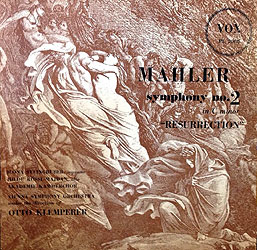
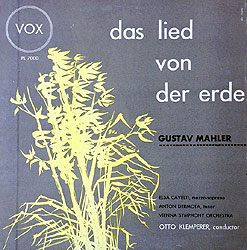 Although explicit emotion would be purged from his later recordings, here it comes barreling through with impulsive tempo swings, although nowhere near as extreme as in the wild pioneering 1924 acoustical recording by Oskar Fried, who actually had led that seminal 1905 performance under Mahler's guidance and thus perhaps provides our most compelling paradigm of the composer's own approach. In keeping with Mahler's invitation to feel free to change anything that didn't sound right, Klemperer adds two pauses in the midst of the first movement climax (at rehearsal # 18) and spotlights braying trumpets in the middle of the third. The Vienna Symphony often can sound underweight, but here their lean playing has a rugged quality that suits the music, even adding a rustic feeling to the middle movements, and largely repudiates any sense of sentimentality, in part due to the overall swift pace (76 minutes, about ten shorter than most).
Although explicit emotion would be purged from his later recordings, here it comes barreling through with impulsive tempo swings, although nowhere near as extreme as in the wild pioneering 1924 acoustical recording by Oskar Fried, who actually had led that seminal 1905 performance under Mahler's guidance and thus perhaps provides our most compelling paradigm of the composer's own approach. In keeping with Mahler's invitation to feel free to change anything that didn't sound right, Klemperer adds two pauses in the midst of the first movement climax (at rehearsal # 18) and spotlights braying trumpets in the middle of the third. The Vienna Symphony often can sound underweight, but here their lean playing has a rugged quality that suits the music, even adding a rustic feeling to the middle movements, and largely repudiates any sense of sentimentality, in part due to the overall swift pace (76 minutes, about ten shorter than most).
To observe the fortieth anniversary of Mahler's 1911 death, following his Vox recording Klemperer led the Resurrection in Amsterdam with the Concertgebouw, which he cited as his favorite orchestra at the time and which had a long history of crusading for Mahler under its late permanent conductor, Willem Mengelberg. A recording of Klemperer's July 12, 1951 Concertgebouw concert is even more intense than his Vox rendition – five minutes faster and with yet greater inflection and finesse, a full sonority, wider dynamics, beautiful poise and especially prominent percussion (barely audible on the Vox). Klemperer further benefited from the participation of contralto Kathleen Ferrier. Despite her claim that "I hate working with Klemperer. � He shouts like a madman," her "Urlicht" song comes across as chillingly sincere and her Mahler Kindertotenlieder that opened the concert is dark and haunting.
A brief digression: Other Concertgebouw concerts provide some valuable correctives to conventional wisdom and assumptions about Klemperer. From the same year as the Amsterdam Resurrection (and the bulk of his Vox recordings) we have a reminder that Klemperer's repertoire ranged beyond the German/Austrian classics that we associate from his records; thus a January 11, 1951 Concertgebouw concert encompassed: the Janacek Sinfonietta, of which Klemperer had given the German and American premieres and which he had included in his first Kroll concert, heard here in a bold, brassy rendition that fully lives up to its original title of "Military Symphony;" the Bartok Viola Concerto with William Primrose for whom it had been written, and which had received its world premiere a mere 13 months earlier; and, in a rare dash of exotica, a suitably atmospheric Falla Nights in the Gardens of Spain. And although Klemperer was on the cusp of his series of even-tempered Philharmonia readings, from 1954 comes a Mozart Symphony # 41 with a furiously-driven finale and from 1958 a deeply Romanticized and heated Schoenberg Verkl�rte Nacht; both dispute the notion that his temperament was limited to solid/stolid, as might appear from his concurrent Philharmonia recordings by which he would became best known. OK, back to Vox �
Mendelssohn: Symphonies #s 3 ("Scottish") and 4 ("Italian") ~ Klemperer's protest against release of the "Scottish" Symphony under his name even though he had not led the final two movements – the source of his rupture with Vox – was as much a textual issue as a matter of personal pique. 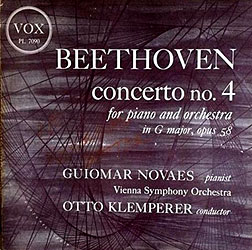
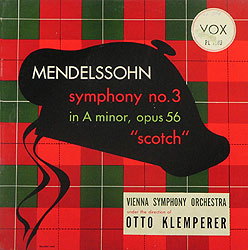 Klemperer felt that Mendelssohn's exuberant coda which launches a new theme with a sudden shift from A-minor to A-major and builds to a majestic conclusion was "very peculiar." Taking inspiration from Mendelssohn's own misgivings over its forceful orchestration, Klemperer claimed "the right to alter the coda fundamentally" using Mendelssohn's materials to recall the work's opening with a more flowing and serene flavor. In his resignation letter to Vox he claimed that he had intended to use his ending to complete his recording. Curiously, though, he would adhere to Mendelssohn's published score in his 1960 Philharmonia remake. (His substitute ending can be heard in a 1969 Bavarian Radio concert issued by EMI.) The Vox performance itself is rather bland and ill-defined, not only in Haefner's portions but in Klemperer's as well. The "Italian" recalls a prime benefit of the LP format, as it includes the nearly three-minute first-movement exposition repeat, a far rarer practice on 78s where timing and space were at a premium. The first three movements are well-paced and fluently played but the mood is spoiled with a ruthlessly-driven finale (under 4� minutes vs. a typical 6 or so) that goes well beyond presto to make little musical sense, even while serving a tangential purpose: the Vienna Symphony often is regarded as a ragged step-child to the Vienna Philharmonic (and indeed some of their work on records, not only for Klemperer but for Horenstein and others, is quite scruffy), but here in that frantic finale they avoid a sonic blur and somehow manage to keep pace through lucid delineation as though to ace a test of pure virtuosity.
Klemperer felt that Mendelssohn's exuberant coda which launches a new theme with a sudden shift from A-minor to A-major and builds to a majestic conclusion was "very peculiar." Taking inspiration from Mendelssohn's own misgivings over its forceful orchestration, Klemperer claimed "the right to alter the coda fundamentally" using Mendelssohn's materials to recall the work's opening with a more flowing and serene flavor. In his resignation letter to Vox he claimed that he had intended to use his ending to complete his recording. Curiously, though, he would adhere to Mendelssohn's published score in his 1960 Philharmonia remake. (His substitute ending can be heard in a 1969 Bavarian Radio concert issued by EMI.) The Vox performance itself is rather bland and ill-defined, not only in Haefner's portions but in Klemperer's as well. The "Italian" recalls a prime benefit of the LP format, as it includes the nearly three-minute first-movement exposition repeat, a far rarer practice on 78s where timing and space were at a premium. The first three movements are well-paced and fluently played but the mood is spoiled with a ruthlessly-driven finale (under 4� minutes vs. a typical 6 or so) that goes well beyond presto to make little musical sense, even while serving a tangential purpose: the Vienna Symphony often is regarded as a ragged step-child to the Vienna Philharmonic (and indeed some of their work on records, not only for Klemperer but for Horenstein and others, is quite scruffy), but here in that frantic finale they avoid a sonic blur and somehow manage to keep pace through lucid delineation as though to ace a test of pure virtuosity.
Beethoven: Piano Concerto # 4; Chopin: Piano Concerto # 2; Schumann: Piano Concerto ~ Along with a rather nondescript Beethoven Fifth Symphony, Klemperer completed his Vox work with these three piano concertos, which provide our first taste in the studio of his infrequent role accompanying renowned solo artists. Guiomar Nov�es had been recording albums of Chopin, Schumann, Beethoven and Mozart for Vox and so as label-mates their collaboration may have arisen more for commercial than artistic reasons, as her style, often described as modest, poetic, spontaneous, natural, relaxed and (gulp) feminine, hardly seemed a likely fit with his reputation for straight-forward sobriety. Yet Klemperer proved an accommodating partner. Along with her cadenzas, their full Schumann concerto and the Andante of the Beethoven are especially tender and the storms of the Chopin are tempered, but throughout Klemperer fashions settings that closely complement, if not outright defer to, her warm and sensitive disposition (although the blurred recordings do her no favors) and in the process illuminates a side of his artistic temperament that rarely surfaces in his symphonic recordings of the time and that might have been deepened by his initial aspiration to become a concert pianist and his early career as an accompanist.
Klemperer's oddest association on records was with the RIAS [Radio In the American Sector] Symphony Orchestra.  As traced by Rudolf Bruil, after World War II the Allied forces, in control of public life in the occupied territories, regrouped existing German orchestras and formed new ones. Based in Berlin and financed by the US government to provide music for radio broadcasts (and to compete with the Soviets), the RIAS orchestra was founded in November 1946 with a core group of musicians from the Staatskapelle and hired the young Hungarian Ferenc Fricsay as its principal conductor. As its funding began to be cut, the orchestra turned increasingly to revenue from recordings, mainly on the Remington label under such renowned conductors as Solti, Bohm, Ormandy and Karajan, and on Deutsche Grammophon under Fricsay with repertoire ranging from Haydn and Mozart to Bartok and Kodaly.
As traced by Rudolf Bruil, after World War II the Allied forces, in control of public life in the occupied territories, regrouped existing German orchestras and formed new ones. Based in Berlin and financed by the US government to provide music for radio broadcasts (and to compete with the Soviets), the RIAS orchestra was founded in November 1946 with a core group of musicians from the Staatskapelle and hired the young Hungarian Ferenc Fricsay as its principal conductor. As its funding began to be cut, the orchestra turned increasingly to revenue from recordings, mainly on the Remington label under such renowned conductors as Solti, Bohm, Ormandy and Karajan, and on Deutsche Grammophon under Fricsay with repertoire ranging from Haydn and Mozart to Bartok and Kodaly.
Among its first guest artists, Klemperer recorded a Mozart program in December 1950 for release on two Italian labels, I Grandi Concerti and Movimento Musica. 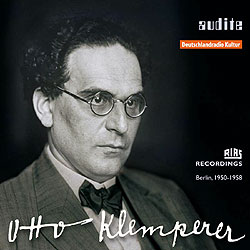 All three symphonies (#s 25, 29 and 38 ("Prague")) receive well-characterized, big-band readings with mindful parity among strings, horns and winds (which can tend to be swamped within full orchestras, as they are here in a stormy Don Giovanni Overture). An unexpected exception is the Serenata Notturna with a suitably reduced ensemble and especially cordial direction. While the Symphony # 25 is virtually identical to the Vox version cut earlier that year, it raises the issue of repeats. Here Klemperer omits the first-movement exposition repeat that is taken in the Vox (and would omit it in his 1956 Philharmonia recording as well). On the other hand, he indulges the first-movement repeat in the Symphony # 38 (but, again, not in his 1963 studio version). Klemperer generally proclaimed the necessity of observing repeats (which were nearly always specified in classical-era scores and in many early Romantic scores as well) but he clearly had mutable thoughts even as to specific pieces. (And that controversy, such as it is, continues to this day – should repeats be respected as a composer's expressed structural dictate, or should they be dismissed as a relic of times long gone when performances were rare and repetitions helped to fix a tune and its unfolding that might never be heard again?) A general difference with Vox lies in the recorded sound – far richer fidelity with genuine bass – making one regret the thin and occasionally fierce sonics of the Vox series (although, admittedly, much of the disparity could be a deceptive artifact of their respective digital transfers).
All three symphonies (#s 25, 29 and 38 ("Prague")) receive well-characterized, big-band readings with mindful parity among strings, horns and winds (which can tend to be swamped within full orchestras, as they are here in a stormy Don Giovanni Overture). An unexpected exception is the Serenata Notturna with a suitably reduced ensemble and especially cordial direction. While the Symphony # 25 is virtually identical to the Vox version cut earlier that year, it raises the issue of repeats. Here Klemperer omits the first-movement exposition repeat that is taken in the Vox (and would omit it in his 1956 Philharmonia recording as well). On the other hand, he indulges the first-movement repeat in the Symphony # 38 (but, again, not in his 1963 studio version). Klemperer generally proclaimed the necessity of observing repeats (which were nearly always specified in classical-era scores and in many early Romantic scores as well) but he clearly had mutable thoughts even as to specific pieces. (And that controversy, such as it is, continues to this day – should repeats be respected as a composer's expressed structural dictate, or should they be dismissed as a relic of times long gone when performances were rare and repetitions helped to fix a tune and its unfolding that might never be heard again?) A general difference with Vox lies in the recorded sound – far richer fidelity with genuine bass – making one regret the thin and occasionally fierce sonics of the Vox series (although, admittedly, much of the disparity could be a deceptive artifact of their respective digital transfers).
The Mozart seems to comprise their only studio session but we do have four Klemperer broadcast concerts with the RIAS from 1954 through 1958 (when it was known as the Berlin Radio Symphony). Throughout that period he became increasingly immersed in the final stage of his career when his suppleness tended to solidify into rigid focus. Thus a sturdy, steady Haydn Symphony # 101 ("Clock"), severe Brahms Symphony # 2 and Beethoven Symphonies 2 and 6, a Strauss Till Eulenspiegel more cautious than mischievous, and a joyless Mahler Fourth (partly redeemed by sensitive voicing of the final song) all hold few surprises. Most successful within this approach are the Beethoven Third ("Eroica") with a massively imposing funeral march and uncommon integration of the finale's variations, and a sturdy Nobilissima Visione ballet suite, our first taste of Klemperer's Hindemith, one of the few contemporary composers he valued and often performed at the Kroll and beyond but rarely recorded.
Walter Legge was nasty, vain and amoral.
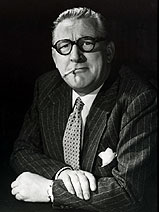 Walter Legge |
From 1954 until his retirement in 1971 Klemperer recorded exclusively for EMI with the Philharmonia with only a single exception – a superb June 1960 Brahms Violin Concerto with David Oistrakh and the French National Radio Orchestra, which Klemperer inspires to sound much like the Philharmonia while complementing the soulful depth and grandeur of the solo playing. 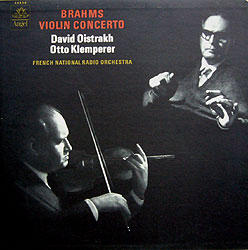 As Karajan drifted away to replace Furtw�ngler at the Berlin Philharmonic, in 1959 Legge appointed Klemperer as the Philharmonia's conductor for life (although, in light of his pressing health issues, a player cracked that it would last only a few weeks). Amid rising tensions with Legge, in June 1963 Klemperer gave advance notice of his resignation in the hope of diversifying his recording activity but failed to attract others' interest. The situation was resolved in March 1964 when Legge disbanded the Philharmonia and out of pique sold off their entire music library; the very next week the players reconstituted the orchestra as the "New Philharmonia," fended off Legge's lawsuit to block their continued use of the name and, as a measure of the bond they had developed, continued to work with Klemperer (who refused further contact with Legge, who had called him an "old fool" when they squabbled over whether to include dialog, which Klemperer considered superfluous, in a projected recording of The Magic Flute). As the decade progressed Klemperer became increasingly frail and the critical divide deepened between those who hailed the purity of his majestic stateliness and others who complained over a lack of vigor, vague rhythm and limp performances.
As Karajan drifted away to replace Furtw�ngler at the Berlin Philharmonic, in 1959 Legge appointed Klemperer as the Philharmonia's conductor for life (although, in light of his pressing health issues, a player cracked that it would last only a few weeks). Amid rising tensions with Legge, in June 1963 Klemperer gave advance notice of his resignation in the hope of diversifying his recording activity but failed to attract others' interest. The situation was resolved in March 1964 when Legge disbanded the Philharmonia and out of pique sold off their entire music library; the very next week the players reconstituted the orchestra as the "New Philharmonia," fended off Legge's lawsuit to block their continued use of the name and, as a measure of the bond they had developed, continued to work with Klemperer (who refused further contact with Legge, who had called him an "old fool" when they squabbled over whether to include dialog, which Klemperer considered superfluous, in a projected recording of The Magic Flute). As the decade progressed Klemperer became increasingly frail and the critical divide deepened between those who hailed the purity of his majestic stateliness and others who complained over a lack of vigor, vague rhythm and limp performances.
Unlike the producers who coaxed Bruno Walter to create a stereo legacy by mostly replicating repertoire he already had issued in mono, to his credit Legge opened new paths for Klemperer that afford an opportunity to consider his approach in a variety of contexts. One constant is the uniform excellence of the orchestra's execution, thus obviating any need for mechanics to distract from the musical experience and often affording a certain satisfaction even in the absence of tangible ardor. A few preliminary observations:
We often read of Klemperer's supposed grasp of architecture and/or structure, but I've never quite understood what that's supposed to mean. A direct connection to the composer's thinking and intent? But all artists strive for that. Viewing a work as a whole? But that seems a function of the composer to arrange elements with cohesion and logic. Focus on a work's basic foundation? But Klemperer also revels in displaying details others tend to obscure. Rock-steady tempos? But Klemperer's generally stable pacing enables him to freshen the impact of subtle inflections. A dearth of emotion? But great music embeds sufficient cues to arouse our feelings more effectively than through blatant displays. 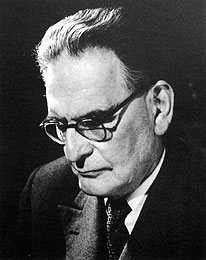 Strict adherence to the written score? But even the "purist" Toscanini recognized that notation is only an outline and insisted that a true musician must read between the lines. And yet, while none of these factors defines Klemperer's late recordings, in a way they all enter into consideration, keeping focus on the work rather than a particular interpretation of the conductor, and thus leaving each listener free to interject one's own feelings and pursue one's own thoughts.
Strict adherence to the written score? But even the "purist" Toscanini recognized that notation is only an outline and insisted that a true musician must read between the lines. And yet, while none of these factors defines Klemperer's late recordings, in a way they all enter into consideration, keeping focus on the work rather than a particular interpretation of the conductor, and thus leaving each listener free to interject one's own feelings and pursue one's own thoughts.
Within a few years after the switch to stereo something happened, as Klemperer adopted the slow, steady approach to which he would generally adhere for the rest of his life. That's not to suggest that this occurred with formulaic precision or mathematical certainty; rather it was a general trend. Consider, for example, his Beethoven Seventh, which grew from a conventional 36 minutes in a 1951 Concertgebouw concert to 37� in 1955 with the RIAS, and then, with the Philharmonia, to 38� in his 1955 mono recording, 41� in a 1960 stereo version, 43 in a 1968 remake and 44� in a 1970 BBC concert. But why? It seems safe to rule out his growing impatience with the recording process. It's true that in a 1969 interview he claimed to "hate this business of constantly moving to the control room to hear what I have recorded," disavowed any preoccupation with detail and technical perfection ("A few mistakes don't matter. � After all, music is a human thing. It isn't a disaster when a horn player gets a bit of saliva on his lips and the tone goes wrong" – a rather odd claim in light of the consistent polish of the Philharmonia's playing), admired Toscanini for insisting on recording in long stretches and refusing to repeat patches, and – unlike nearly all other conductors – asserted his priorities by preparing his recordings as rehearsals for concerts rather than using concerts as a means of burnishing interpretations for the permanence of recordings. Yet the same trend of slowing down emerges in his live performances. Consider the timings of two vastly different Beethoven concert cycles – a 1960 Vienna Festival set is nearly identical to his recordings a few years before, while a 1970 Beethoven cycle filmed by the BBC has tempos consistently slower than any of his (and nearly anyone else's) Beethoven records. Nor does religion seem to have played a major role. Unlike Celibidache, whose zen beliefs informed his extreme slackening, nor Walter, whose embrace of anthroposophy deemphasized materiality in favor of "higher spheres," Klemperer's return to Judaism was reflected less in contemplative reverence than social activism, as he became an increasingly strong advocate for Israel. 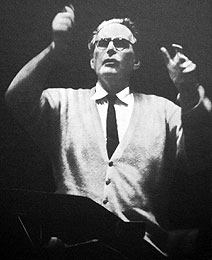 Rather, his deceleration seems a function of the inevitable slowing of mind and body with advancing age (and the consequent tendency to simplify thought), exacerbated in his case by the cumulative weight of his medical setbacks. After all, it's hard to think fast and demand precision when you can barely move.
Rather, his deceleration seems a function of the inevitable slowing of mind and body with advancing age (and the consequent tendency to simplify thought), exacerbated in his case by the cumulative weight of his medical setbacks. After all, it's hard to think fast and demand precision when you can barely move.
It's essential to note that Klemperer's reputation during his final years as severe, monolithic, pure, aloof and antithetical to emotional indulgence does not translate to literalism and treating written notation as sacrosanct. Consider the finale of his 1959 Beethoven Eroica where he adds huge deceleration to the end of the introduction although none is indicated in the score, and overwhelming volume to the tympani toward the end of its coda, even though the score merely indicates forte. He also applied "retouching," a practice indulged by Wagner and Mahler to adjust instrumentation to bolster melodic lines and compensate for other skewed balances wrought by changes in instrument manufacture; Klemperer occasionally doubled winds and horns to compensate for string domination and, conversely, halved the violins opening the Eroica funeral march for a more plaintive texture. Indeed Klemperer defended the role of a conductor as more than a mere traffic cop but essential to inject a degree of intuition and improvisation so that "music is a part of life itself" rather than a machine-like exercise. At the same time, he recalled that Mahler, whom he considered the greatest of all conductors, kept strict time in the classics and he was a lifelong admirer of Toscanini, whom he regarded as "conducting from the heart," "simple, natural and honest" with "the subtlest nuances of interpretation," ideals that came to flavor his own ultimate outlook.
I'm hesitant to delve deeply into this final phase of Klemperer's recordings since they are by far his best known. Indeed most reviews and commentaries dwell upon them to the exclusion of the vastly broader sweep and import of all that came before. So to avoid redundancy I'll attempt just an overview and some highlights. Yet it would be unwise by way of deemphasis to infer that Klemperer's EMI recordings should be devalued or to discount their significance. While many of his earlier records arguably convey more of a work's essence, so do plenty of others. On the other hand, even when Klemperer's late recordings can seem tiresome, frustrating or misguided, they are undeniably unique, documenting a distinctive approach that simply can't be mistaken for any other. 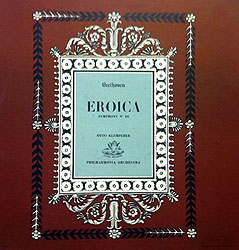
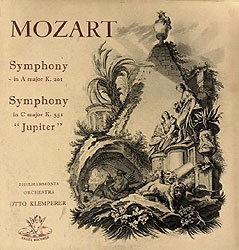 To that extent they are an irreplaceable part of our cultural heritage and deserve to be cherished. (I might also add on a personal note that, as I age and as my own pace slackens, readings that once seemed hopelessly uninvolving have a way of becoming increasingly relevant and meaningful in ways I had not foreseen or appreciated.)
To that extent they are an irreplaceable part of our cultural heritage and deserve to be cherished. (I might also add on a personal note that, as I age and as my own pace slackens, readings that once seemed hopelessly uninvolving have a way of becoming increasingly relevant and meaningful in ways I had not foreseen or appreciated.)
The Mono EMIs ~ Klemperer's initial EMI sessions were recorded monaurally and soon tended to cluster around a single composer's work. But before the first such bundle in which he would tackle Beethoven – three symphonies (#s 3, 5 and 7) and four overtures (Fidelio and the three Leonores) – he began his association with EMI in October 1954 with a mixed program – a well-balanced and fairly vigorous Mozart "Jupiter" Symphony with movement timings that would prove nearly identical to original instrument versions of a generation later (e.g., Norrington/London Classical Players); a restrained Brahms Haydn Variations that eschews both peaks and valleys for a smooth flow among its diverse sections; a moderate, modest Mozart Symphony # 29 that replicates the pacing of the RIAS recording but displays more prominent horns; and the Hindemith Nobilissima Visione. He returned the next month for the four overtures to Beethoven's only opera followed by the four Bach Orchestral Suites, all of which would be recut in stereo and in richer sound – the overtures in 1964 with broader pacing and more modulated dramatic episodes (especially in Leonore I), and the Suites in 1969, weighty, thick and severe, wrapping up with a downright morose R�jouissance.
A year later Klemperer devoted his last mono EMI sessions to the Third ("Eroica"), Fifth and Seventh Beethoven symphonies. (The Seventh was taped in "experimental" stereo but released in that format only on open-reel tape.) His only prior studio rendition of these was the 1951 Vienna Symphony Fifth on Vox, which the EMI closely emulates (including the rarely heard finale exposition repeat) but with more assertive playing and fuller sound. Many critics consider these the peak of Klemperer's Beethoven, displaying an ideal balance of gravity and strength when compared to his stereo remakes.
Early Stereo ~ Klemperer's first stereo session was an aborted attempt at the Brahms First Symphony in December 1955. His first completed stereo recordings the following March were of unexpected repertoire, comprising works for strings alone: Mozart's Eine Kleine Nachtmusik, Serenata Notturna and Adagio and Fugue, Handel's Concerto Grosso, Op 6 # 4, and Felix Weingartner's orchestration of Beethoven's Grosse Fuge. 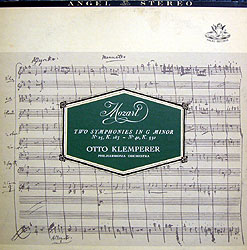
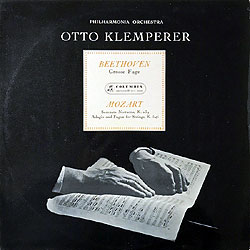 They received unusual distribution as well: although apparently taped in stereo, none was issued in that format at the time, perhaps since consumer stereo installations had yet to reach a critical mass – a pity, since the Mozart Serenata would have seemed a natural candidate for the new technology to vaunt the interplay of its two string orchestras, and in its later stereo CD incarnation the Handel reveals a rich spatial spread and lush sound that complement its leisurely pace (a full 30% slower than the more typical Marriner/St. Martin-in-the-Fields recording). Perhaps the most regrettable loss was the Grosse Fuge. Even though the Weingartner arrangement smooths the rough textures, pares the tension and curtails the visceral impact of the players' struggle in the original quartet format, it boasts a certain historical validity when heard in stereo. Throughout the work Beethoven took great pains to mischievously divide the lead role between the two violins of the quartet setting, rather than relegate the second seat player to its traditional role of being a mere second fiddle, so to speak. By separating his first and second violins to the left and right of the podium (and hence of the recorded stereo soundstage) as he routinely did in all his stereo recordings, Klemperer created an effective aural analog to the visual impact of seeing a quartet in performance, as Beethoven surely intended. While the stereo "ping pong" effect of trills and other phrases careening back and forth between the two speakers belies concert-hall ambience, it serves as a brilliant and highly effective means of restoring the wonder of Beethoven's scoring, which is lost in the standard orchestral seating (and in all monaural recordings) where all the violins are massed together and the two violin parts barely can be distinguished. All of that is missed when folded down to mono, as Klemperer's Grosse Fuge was originally issued. (The Mozart Nachtmusik and Handel concerto were released only in Europe; the Adagio and Fugue, originally coupled with the Serenata and Grosse Fugue on a mono LP, would emerge on a stereo disc of Mozart overtures, but not until 1965. Stereo versions of the other four pieces all would await CDs.)
They received unusual distribution as well: although apparently taped in stereo, none was issued in that format at the time, perhaps since consumer stereo installations had yet to reach a critical mass – a pity, since the Mozart Serenata would have seemed a natural candidate for the new technology to vaunt the interplay of its two string orchestras, and in its later stereo CD incarnation the Handel reveals a rich spatial spread and lush sound that complement its leisurely pace (a full 30% slower than the more typical Marriner/St. Martin-in-the-Fields recording). Perhaps the most regrettable loss was the Grosse Fuge. Even though the Weingartner arrangement smooths the rough textures, pares the tension and curtails the visceral impact of the players' struggle in the original quartet format, it boasts a certain historical validity when heard in stereo. Throughout the work Beethoven took great pains to mischievously divide the lead role between the two violins of the quartet setting, rather than relegate the second seat player to its traditional role of being a mere second fiddle, so to speak. By separating his first and second violins to the left and right of the podium (and hence of the recorded stereo soundstage) as he routinely did in all his stereo recordings, Klemperer created an effective aural analog to the visual impact of seeing a quartet in performance, as Beethoven surely intended. While the stereo "ping pong" effect of trills and other phrases careening back and forth between the two speakers belies concert-hall ambience, it serves as a brilliant and highly effective means of restoring the wonder of Beethoven's scoring, which is lost in the standard orchestral seating (and in all monaural recordings) where all the violins are massed together and the two violin parts barely can be distinguished. All of that is missed when folded down to mono, as Klemperer's Grosse Fuge was originally issued. (The Mozart Nachtmusik and Handel concerto were released only in Europe; the Adagio and Fugue, originally coupled with the Serenata and Grosse Fugue on a mono LP, would emerge on a stereo disc of Mozart overtures, but not until 1965. Stereo versions of the other four pieces all would await CDs.)
Mozart ~ The next sessions in July 1956 were devoted to five Mozart symphonies (plus a rather monolithic Beethoven Consecration of the House Overture that would be redone three years later). We have no prior Klemperer renditions of #s 39 or 40, but the others (#s 25, 36 and 38) all are roughly comparable to their prior Vox and/or RIAS versions. #s 25 and 36 would stand as Klemperer's last takes on these works, their outer movements especially vital with strong accents, dynamics and bass. The other three would be remade in 1962 along with # 41 ("Jupiter"), followed by #s 31 and 34 in 1963 and #s 29 and 33 in 1965 (all but # 29 in his first recordings). As the years progress, they all tend to reflect a trend of broadening tempos offset by clear textures and careful balances, precise but not stiff, leisurely but not languid, as though to eschew imposing any interpretive gloss and thus enabling each listener to apply his or her own inferences to the listening experience. 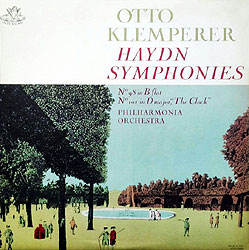
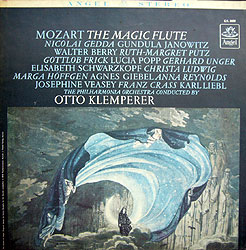 (In comparison, the well-received contemporaneous "big band" sets of late Mozart symphonies led by Karl Bohm and Bruno Walter, two of Klemperer's fellow elder German-trained contemporaries, generally forego the repeats that Klemperer indulges and take swifter tempos but with comparable care to establish equilibrium among the instrumental choirs.) Typically, critics seemed divided between considering Klemperer's renditions rigid and colorless vs. respecting his faithful tempos, phrasing, dynamics and balances.
(In comparison, the well-received contemporaneous "big band" sets of late Mozart symphonies led by Karl Bohm and Bruno Walter, two of Klemperer's fellow elder German-trained contemporaries, generally forego the repeats that Klemperer indulges and take swifter tempos but with comparable care to establish equilibrium among the instrumental choirs.) Typically, critics seemed divided between considering Klemperer's renditions rigid and colorless vs. respecting his faithful tempos, phrasing, dynamics and balances.
Nearly every other aging conductor curtailed the enormous production headaches of grand opera to focus on instrumental music, but Klemperer recorded the great Mozart operas well into his eighties. The burden is reflected in studio logs – while at most a few days were needed to record a typical symphony, the operas required up to several weeks. His Magic Flute (1964) still is acclaimed not only for its stellar cast but for the transparency of the Philharmonia's playing and the unity of Klemperer's overall conception, and indeed it flows magically from start to finish (and the absence of dialog helps to deflect attention from the silly plot – Klemperer surely was right to go to the mat with Legge on that point). But from there things went downhill – while his 1966 Don Giovanni may have benefited from his increasing solemnity and sheer weightiness, they did no favors to his 1970 Marriage of Figaro nor especially his 1971 Cos� fan tutte which were roundly mauled as sullen and stilted travesties of Mozart's light-hearted farces.
Haydn ~ As with his Mozart, we hear a deepening trend as the decade of Klemperer's Philharmonia Haydn recordings progressed. He once commented that a conductor "should begin with Haydn, go on to Mozart, Beethoven and Schubert and then one may be able to move on to more recent and more complicated music," thus implying that he viewed Haydn as the least challenging of the great composers to perform. Indeed, he treated Haydn as pure music with an approach of dignity and respect, suppressing the wit and playfulness mined by others. The overall plan was set in his first Haydn recording in January 1960 of the Symphony # 98 – a deeply-felt introduction with wide dynamics followed by an Allegro whose weight is somewhat relieved by rhythmic precision and bright textures, a solemn Andante, a Menuetto grounded by sluggish pacing and a finale that regains some of the lost vigor. # 101 (the "Clock") is the only Haydn he seemed to program with any frequency and it benefits from a somewhat more focused reading and a livelier Andante. There followed #s 88 and 104 in 1964 (the former presented as notably lighter in keeping with its nature, and both comprising his first sessions with the New Philharmonia) and then #s 100 and 102 in 1965. Superficially, most of the movement timings match those of labelmate Thomas Beecham's classic early 1960s Royal Philharmonic set – but not Klemperer's steadfast pacing and humorless demeanor, especially in the percussive Andante march that gave # 100 ("Military") its descriptive nickname,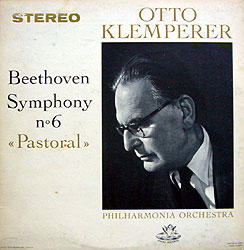
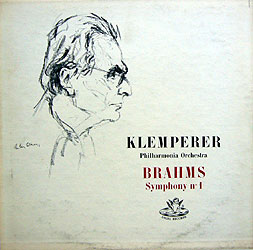 which Beecham treats as a sly game of toy soldiers while Klemperer grimly marches his troops toward a real if feeble battle. Among Klemperer's very last recordings, his 1970 # 95 and 1971 # 92 have become deadly serious, perhaps an intentional connection to the more consequential German repertoire that Haydn would spawn in the generations to come, but far removed from our established view of Haydn as a master of esprit.
which Beecham treats as a sly game of toy soldiers while Klemperer grimly marches his troops toward a real if feeble battle. Among Klemperer's very last recordings, his 1970 # 95 and 1971 # 92 have become deadly serious, perhaps an intentional connection to the more consequential German repertoire that Haydn would spawn in the generations to come, but far removed from our established view of Haydn as a master of esprit.
Brahms and Beethoven ~ Back to our chronology � Klemperer's next studio sessions (October 29 – November 1, 1956 and March 26-29, 1957) were devoted to the four symphonies and two overtures of Brahms, followed in October 1957 by the six Beethoven symphonies needed to complete the mono cycle, of which the Third ("Eroica") and Fifth would be remade in stereo two years later and the Seventh a year after that. In terms of their pacing, Klemperer's Brahms falls well within the range of his contemporaries – he's actually faster than Jochum, Walter and Bernstein/NYP – and the overall impression is far less monumental than often is claimed. Brahms is inherently weighty yet lyrical, and Klemperer reduces tension and resists any temptation to dramatize or to accelerate climaxes in favor of momentum and inevitability, with just enough tempo variation to maintain interest without bogging down or calling attention to interpretive intervention, while abetting the lyricism with his trademark bright sonority and antiphonal string placement. (Here I should note that my first exposure to Klemperer's Brahms was on original US Angel LPs that sounded depressingly dull and colorless; only later did I discover the far more vibrant sound of European EMI pressings, confirmed by CD reissues.)
Much the same can be said of Klemperer's stereo Beethoven. 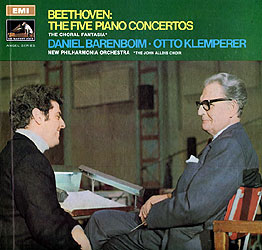
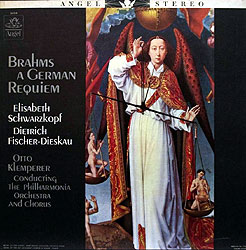 If the heft he adds to the first two symphonies disavows debts to Haydn and provides an entr�e to Beethoven's maturity, he manages to draw attention to their inherent gentleness and emotional proportion. The Pastoral, shorn of any pretense of associations with nature, peasant dances and actual thunderstorms, emerges instead as an absorbing piece of abstract music. Elsewhere the thick textures exemplify the phenomenon of our subjective perception of speed – the weighty, steady Adagio in Klemperer's Ninth may seem prolonged, but its timing is on track with literalists – identical to Weingartner, a mere half-minute longer than Toscanini and 1� minutes faster than Karajan. Along with an equally stately Eroica and Fifth, the stalwart Ninth underlines Klemperer's authority in this repertoire (and his commercial clout as well – expressly for his Ninth Legge created the Philharmonia Chorus, which went on to a glorious career of its own and thrives to this day). Except for a glacial 1968 Seventh remake, Klemperer's late 1950s cycle was his last word on the Beethoven symphonies in the studio, and yet a truly unique experience is a final concert series, filmed by the BBC in June 1970 – the slowest on record, with a 58-minute Eroica (without repeats) and culminating in an 81� minute Ninth, affording a special opportunity to luxuriate in an inimitable concept of temporal space.
If the heft he adds to the first two symphonies disavows debts to Haydn and provides an entr�e to Beethoven's maturity, he manages to draw attention to their inherent gentleness and emotional proportion. The Pastoral, shorn of any pretense of associations with nature, peasant dances and actual thunderstorms, emerges instead as an absorbing piece of abstract music. Elsewhere the thick textures exemplify the phenomenon of our subjective perception of speed – the weighty, steady Adagio in Klemperer's Ninth may seem prolonged, but its timing is on track with literalists – identical to Weingartner, a mere half-minute longer than Toscanini and 1� minutes faster than Karajan. Along with an equally stately Eroica and Fifth, the stalwart Ninth underlines Klemperer's authority in this repertoire (and his commercial clout as well – expressly for his Ninth Legge created the Philharmonia Chorus, which went on to a glorious career of its own and thrives to this day). Except for a glacial 1968 Seventh remake, Klemperer's late 1950s cycle was his last word on the Beethoven symphonies in the studio, and yet a truly unique experience is a final concert series, filmed by the BBC in June 1970 – the slowest on record, with a 58-minute Eroica (without repeats) and culminating in an 81� minute Ninth, affording a special opportunity to luxuriate in an inimitable concept of temporal space.
Klemperer was so pleased with his successful collaboration with Daniel Barenboim in a March 1967 Mozart Piano Concerto # 25 that they proceeded to dispatch all five Beethoven piano concertos in a mere four days that October, followed by the Choral Fantasia. But rather than a clash of temperament that their 60-year age difference might suggest, the result blends well – Barenboim (whose own acclaimed sets of Beethoven sonatas and self-directed Mozart concertos were broadly cast) plays with lyricism and moderation while Klemperer tempers his growing solemnity, if only somewhat, to provide an attentive orchestral foundation.
While the merits of Klemperer's Philharmonia Beethoven and Brahms symphony cycles can be debated,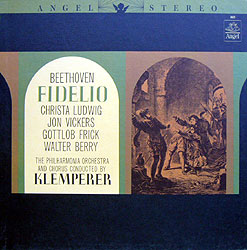
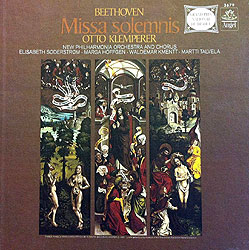 ranging from disparaging (lacking subtlety or charm; ponderous tempos; unvarying austere manner) to effusive (purity of style; careful balances; penetrating profundity), his recordings of the Beethoven Missa Solemnis (1965) and Brahms German Requiem (1961) still garner near-universal praise and remain toward, or even at, the top of most "best" lists. Both are shorn of rhetoric, are played with maturity, nobility, repressed energy and self-assurance, and are approached as pure music, thus inviting each auditor to project one's own expectations and find one's own fulfilment. Yet the Missa smooths out much of Beethoven's innate drama and represses his energy and tension, purging the Dona nobis pacem fugue of even a hint of its urgency and anger, even as bright detail illuminates aspects of the inner workings that more overtly reverential or emotionally intense accounts can obscure. The Brahms, too, steering a middle course between serene spirituality and probing fervency, emerges as surprisingly light, unfolding with exquisite poise and balance, nestling superstar soloists Dietrich Fischer-Dieskau and Elisabeth Schwartzkopf well within the orchestral and choral fabric. Here, as with the symphonies, tempos are unexpectedly brisk, faster than such acclaimed versions led by Karajan, Kempe, Solti, Haitink, Levine – and even Toscanini! Both the Beethoven and Brahms have an intangible quality of permanence that invite return visits more than a singular viewpoint that can prove tiring – a fully appropriate vision in matters of deeply personal religious inspiration. Most critics heap similar acclaim on Klemperer's 1962 studio Fidelio, but to me it seems overly formal, drained of the sense of joyous affirmation envisioning a future when humanity ultimately triumphs over repression, an autumnal reflection rather than a galvanic manifesto surging with righteous indignation and, ultimately, ecstatic celebration, all of which Klemperer had nailed in his astounding 1948 Budapest performance.
ranging from disparaging (lacking subtlety or charm; ponderous tempos; unvarying austere manner) to effusive (purity of style; careful balances; penetrating profundity), his recordings of the Beethoven Missa Solemnis (1965) and Brahms German Requiem (1961) still garner near-universal praise and remain toward, or even at, the top of most "best" lists. Both are shorn of rhetoric, are played with maturity, nobility, repressed energy and self-assurance, and are approached as pure music, thus inviting each auditor to project one's own expectations and find one's own fulfilment. Yet the Missa smooths out much of Beethoven's innate drama and represses his energy and tension, purging the Dona nobis pacem fugue of even a hint of its urgency and anger, even as bright detail illuminates aspects of the inner workings that more overtly reverential or emotionally intense accounts can obscure. The Brahms, too, steering a middle course between serene spirituality and probing fervency, emerges as surprisingly light, unfolding with exquisite poise and balance, nestling superstar soloists Dietrich Fischer-Dieskau and Elisabeth Schwartzkopf well within the orchestral and choral fabric. Here, as with the symphonies, tempos are unexpectedly brisk, faster than such acclaimed versions led by Karajan, Kempe, Solti, Haitink, Levine – and even Toscanini! Both the Beethoven and Brahms have an intangible quality of permanence that invite return visits more than a singular viewpoint that can prove tiring – a fully appropriate vision in matters of deeply personal religious inspiration. Most critics heap similar acclaim on Klemperer's 1962 studio Fidelio, but to me it seems overly formal, drained of the sense of joyous affirmation envisioning a future when humanity ultimately triumphs over repression, an autumnal reflection rather than a galvanic manifesto surging with righteous indignation and, ultimately, ecstatic celebration, all of which Klemperer had nailed in his astounding 1948 Budapest performance.
Bach ~ Klemperer's recordings of weighty Bach choral works are more contentious. He unabashedly proclaimed the Mass in B Minor "the greatest and most unique music ever written" as well as the hardest work he had ever conducted. 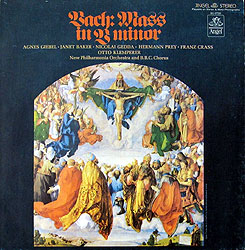
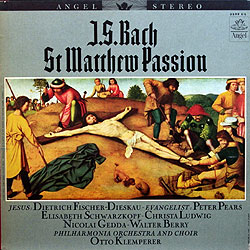 Perhaps out of awe, before his 1967 recording he had only led it once, and that had been in 1932. He had devoted weeks of rehearsal to that performance and had struggled with how to adapt the work's original modest forces to the voluminous setting of a modern concert hall. For his recording, which required 11 sessions, he insisted on proceeding in proper sequence, and he expressed rare satisfaction with the outcome – in a 1969 interview he claimed that the opening Kyrie was the only one of his records to which he ever listened. Despite his professed ideal of using only a few instrumentalists and singers in each part to bring out the polyphony as clearly as possible, here he compromised with 48 voices, 33 strings and 12 winds. Even with such relatively modest forces the result is monumental, steady and somber, gaining power through the force of its sheer sustained weight at the expense of its more delicate moments. Such resolute solidity is taken to the extreme in his 1960 St. Matthew Passion, which weighs in at nearly four hours and defies modern notions of Bach performance, not only by being absolutely uncut but in the extreme deliberation of the choral portions. Peaceful and soothing throughout, some find it deeply moving and devotional, its tenacious solemnity fully appropriate to the subject, while for others it's unduly static, with attenuated emotion and purged of its human drama.
Perhaps out of awe, before his 1967 recording he had only led it once, and that had been in 1932. He had devoted weeks of rehearsal to that performance and had struggled with how to adapt the work's original modest forces to the voluminous setting of a modern concert hall. For his recording, which required 11 sessions, he insisted on proceeding in proper sequence, and he expressed rare satisfaction with the outcome – in a 1969 interview he claimed that the opening Kyrie was the only one of his records to which he ever listened. Despite his professed ideal of using only a few instrumentalists and singers in each part to bring out the polyphony as clearly as possible, here he compromised with 48 voices, 33 strings and 12 winds. Even with such relatively modest forces the result is monumental, steady and somber, gaining power through the force of its sheer sustained weight at the expense of its more delicate moments. Such resolute solidity is taken to the extreme in his 1960 St. Matthew Passion, which weighs in at nearly four hours and defies modern notions of Bach performance, not only by being absolutely uncut but in the extreme deliberation of the choral portions. Peaceful and soothing throughout, some find it deeply moving and devotional, its tenacious solemnity fully appropriate to the subject, while for others it's unduly static, with attenuated emotion and purged of its human drama.
Klemperer rerecorded the Bach Brandenburg Concertos in 1960 and the Orchestral Suites in 1969. I'm at a loss to understand the consistent rave reviews they still garner. The Brandenburgs present the same careful balances and bright textures as his 1946 Vox Pro Musica set but now displayed with clearer sonics and spread over a stereo soundstage, and the Suites update a November 1954 mono set cut toward the dawn of his EMI/Philharmonia association; yet in both cases the tempos have become severely bloated and suggest (to me) more of a dissection of the score than a fluid performance, a slow-motion conveyance to permit careful examination rather than a wondrous celebration of Bach's genius. 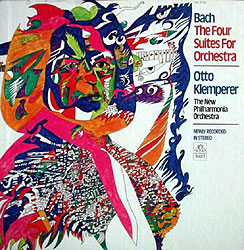
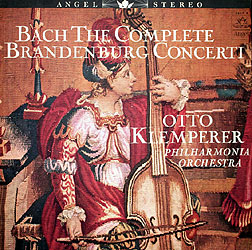 (The Brandenburgs were issued in America with a suitably traditional cover of a Baroque gamba player, but what a wildly perky cover for the Suites – if only the contents were half as vibrant!) The Vox (and even the Philharmonia remakes) may have been considered laudable in their time for renouncing interpretive gloss, but time sails on and in its wake we now have dozens of wonderful renditions on record from the brisk clarity of historically-informed sets to the deep commitment of romantically-steeped ones that invest these works with essential human feelings.
(The Brandenburgs were issued in America with a suitably traditional cover of a Baroque gamba player, but what a wildly perky cover for the Suites – if only the contents were half as vibrant!) The Vox (and even the Philharmonia remakes) may have been considered laudable in their time for renouncing interpretive gloss, but time sails on and in its wake we now have dozens of wonderful renditions on record from the brisk clarity of historically-informed sets to the deep commitment of romantically-steeped ones that invest these works with essential human feelings.
Handel ~ Aside from that single 1956 Concerto Grosso, a 1964 Messiah was Klemperer's only foray into Handel. With a big-band approach but without big band sonority, he used a reduced chorus and orchestra and emerges poised somewhere between the extreme tempos (Scherchen), personalities (Bernstein, Stokowski), massive forces (Sargent, Ormandy) and rearrangements (Sargent, Beecham, Bernstein) of yore and more modern efforts to replicate with historical authenticity the thinner, more responsive, less personal approach of Handel's time. As Beecham asserted in notes to his 1959 recording, "some reasonable compromise must be effected between excessive grossness and exaggerated leanness of effect." Balances are alert, the soloists bold if a bit too operatic, the chorus rich and responsive, and the continuo discreet yet distinctive. As was prevalent at the time, this is not a complete rendition, as it cuts a half-dozen numbers and pares some repeats. While the world may not be in dire need of more Messiahs – the oratorio, not deliverance from our political and social ordeals – the Messiah: The Complete Guide website lists over 260 (!) so far – and while unlikely to zoom to the top of anyone's list of irreplaceable renditions, the Klemperer Messiah remains a judicious, everyday account that presents (most of) the music responsibly and effectively.
Mendelssohn ~ In a 1960 article published in Munich, Klemperer expressed outrage that the German composers and teachers union, under the lingering influence of fascists, "was not ashamed to commit such a monstrosity as its silence over the anniversaries of Mendelssohn and Mahler" whose achievements as hugely influential conductors as well as composers "should never be forgotten." His own Mendelssohn observance that year included a rather stodgy "Scottish" Symphony (using the original ending, despite his misgivings, rather than his own reworking), a sensibly-paced "Italian" Symphony that broadens the finale from the frantic haste of his Vox recording,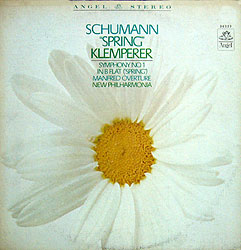
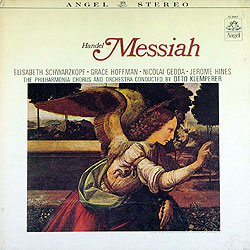 and not only the well-known overture but the complete incidental music to A Midsummer Night's Dream to which he brings a variety of textures and occasionally uncharacteristic delicacy within expectedly patient tempos that can't avoid casting an overall pall of formality, if not solemnity.
and not only the well-known overture but the complete incidental music to A Midsummer Night's Dream to which he brings a variety of textures and occasionally uncharacteristic delicacy within expectedly patient tempos that can't avoid casting an overall pall of formality, if not solemnity.
Schumann ~ More than any others, the Schumann symphonies tend to attract debate about the necessity of "retouching" the scores, mostly to lighten Schumann's doublings that thicken his textures. Leonard Bernstein's early 1960s recordings boasted of using the original orchestrations so that "the listener is given the unique opportunity of hearing the work just as Schumann left it, unburdened with the usual revisions designed to 'correct' the composer's reputed deficiencies as an orchestrator" [emphases added], thus reflecting the prevalence of the practice of rescoring up to that point. While Klemperer felt that Wagner's and Mahler's revisions had gone too far and that "one can bring out the full content of such music without retouching" he nonetheless felt it necessary in Schumann, deriding as "nonsense" the notion of considering the pure text as faithfulness to a score or the fear of changing a single note to bring out its character. Klemperer's prudent approach finesses the issue through his characteristically bright textures and uncharacteristic tempo flexibility, and especially enlivens his 1965 account of the Schumann Symphony # 1 to live up to its sobriquet of "Spring." His 1960 Fourth is convincing as well, but the 1968 Second and 1969 Third never catch fire and seem to overstay their welcome, as does the rarely-heard prim Faust Overture.
Tchaikovsky ~ In 1935 Klemperer had protested that "Tchaikovsky has been the victim of the conductor. Year after year the interpretation of Tchaikovsky has become more and more exaggerated, more and more hysterical and filled with false emotion. " Rather, Klemperer considered him "a sincere composer with a great melodic gift, who wrote simply and sincerely from his heart." Although Klemperer claimed to have admired passionate performances of the Tchaikovsky Fifth by Furtw�ngler and Sixth ("Pathetique") by Nikisch, his only Tchaikovsky recordings (1961-3) seem to have followed his earlier pursuit of self-control – his Fourth surrounds lovely renditions of the inner movements with rather constipated, tightly-controlled outer ones (although that scheme does serve to amplify the elation of the triumphant peroration), while his Fifth and Sixth blunt their intrinsic and essential dynamism. (This seems an opportune time to salute the fitting cover images Angel provided for many of their Klemperer albums, which often exemplify the works but occasionally seem to muse on Klemperer's approach. Here the Angel cover for the Fifth accurately reflects, albeit perversely, the dour performance.)
Wagner: Der fliegende Holl�nder ~ Although critics of the time denounced it as "unparalleled cultural shamelessness," 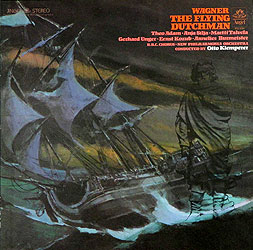
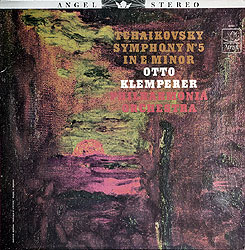 "an irresponsible attempt to destroy" and an "artistic betrayal of the people" "by a group of degenerates," Klemperer's 1929 Kroll production of The Flying Dutchman in modern dress and with spare sets proved a huge success and forecast the post-war trend of innovative Wagner staging. At Richard Strauss's suggestion, Klemperer bypassed Wagner's many revisions of this early work by reverting to the original instrumentation (e.g., removing the stirring redemption motif from the end of the overture and announcing the Dutchman's Act II entrance with a blast of trombones rather than plucked strings), although he adhered to the ultimate three-act format rather than the initial presentation as an uninterrupted and exhausting 2� hours. This 1968 Dutchman was not only the sole Wagner opera Klemperer ever cut in the studio, but arguably was his last compelling recording before lapsing into his final phase of unrelieved torpor, and thus serves as a suitable pendant to some full-blooded Wagner overtures, preludes and orchestral excerpts he had recorded in 1960. Although 15 minutes slower than customary renditions, it bursts with joy when apt (e.g., the ecstatic betrothal that ends Act II) and yet envelops the entire work with a pervasive feeling of gloom and destiny (especially the sailor's dance and revelry that opens Act III which proceeds glumly and oppressively), suitably serving to underscore the subtext of immutable fatalism that imbues the entire conception.
"an irresponsible attempt to destroy" and an "artistic betrayal of the people" "by a group of degenerates," Klemperer's 1929 Kroll production of The Flying Dutchman in modern dress and with spare sets proved a huge success and forecast the post-war trend of innovative Wagner staging. At Richard Strauss's suggestion, Klemperer bypassed Wagner's many revisions of this early work by reverting to the original instrumentation (e.g., removing the stirring redemption motif from the end of the overture and announcing the Dutchman's Act II entrance with a blast of trombones rather than plucked strings), although he adhered to the ultimate three-act format rather than the initial presentation as an uninterrupted and exhausting 2� hours. This 1968 Dutchman was not only the sole Wagner opera Klemperer ever cut in the studio, but arguably was his last compelling recording before lapsing into his final phase of unrelieved torpor, and thus serves as a suitable pendant to some full-blooded Wagner overtures, preludes and orchestral excerpts he had recorded in 1960. Although 15 minutes slower than customary renditions, it bursts with joy when apt (e.g., the ecstatic betrothal that ends Act II) and yet envelops the entire work with a pervasive feeling of gloom and destiny (especially the sailor's dance and revelry that opens Act III which proceeds glumly and oppressively), suitably serving to underscore the subtext of immutable fatalism that imbues the entire conception.
Bruckner ~ Given Klemperer's reputation and general propensity for patiently unfolding massive patterns, all of Bruckner's symphonies would seem a natural fit, and throughout his earlier career Klemperer doggedly fought audiences, critics and concert organizers to program them as often as he could despite their unpopularity. (A 1932 London critic typically dismissed the Seventh as "not merely na�ve, it is uneducated, badly conceived, badly worked out, badly orchestrated. In fact, it is not worth discussing.") The six Bruckner symphonies Klemperer recorded with the Philharmonia and its "New" offshoot show a clear pattern. The Fourth, the first of the batch to be taped in 1963 (and admittedly the most variegated Bruckner symphony), boasts a keen balance of impetus and control, capturing all its nuances without getting bogged down or unduly carried away, fueled by snappy brass and razor-sharp playing, the result every bit as effective in its own way as the proactive approach typified by Furtw�ngler and Abendroth. As Klemperer's first recording with the New Philharmonia after warming up with Haydn and Mozart, a 1964 Sixth largely follows suit, but then their 1965 Seventh and 1967 Fifth, while avoiding monolithic tempos, seem disjointed and rarely come alive. 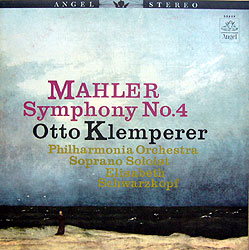
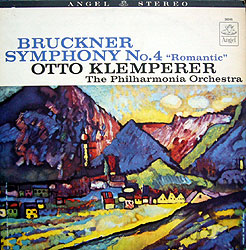 The series ended with a 1970 Eighth and Ninth that sound tired, aimless, diffuse, unbearably sluggish and – despite Klemperer's rationale for two deep cuts in the finale of the Eighth ("It seems to me that the composer was so full of musical invention that he went too far") – just too long, the worst sin in Bruckner performance.
The series ended with a 1970 Eighth and Ninth that sound tired, aimless, diffuse, unbearably sluggish and – despite Klemperer's rationale for two deep cuts in the finale of the Eighth ("It seems to me that the composer was so full of musical invention that he went too far") – just too long, the worst sin in Bruckner performance.
Mahler ~ And last but certainly not least � While throughout his career Klemperer repaid with fervent advocacy the composer/conductor/mentor to whom he owed his start, his five EMI Mahler recordings reflect the same trend as his Bruckner. 1961 brought superb renditions of the Fourth and Second ("Resurrection") Symphonies. The Fourth undoubtedly held a special place in Klemperer's affections, as it had anchored the first orchestral concert he ever led. While not quite as inflected as the Fourths documented by fellow Mahler acolytes Mengelberg and Walter, Klemperer comes remarkably close in a convincing rebuttal to his late reputation as consistently literal and inflexible; indeed, this is among the most plastic and versatile of all his EMI Philharmonia recordings, full of nuance, with potent climaxes, breathtaking tempo control and a tangible rustic effect from his assertive winds and horns. While few critics applaud Elizabeth Schwartzkopf's rendition of the final song, she manages to contain her lieder and operatic tendencies to convey much of its na�vet�. (She might not have been Klemperer's choice – she was Legge's wife.) Beginning with Oskar Fried, another Mahler disciple, in his pioneering 1923 acoustical recording, others have evoked more of the sweeping psychic journey with which Mahler infused his Second, but Klemperer's account scores by suppressing its intrinsic emotion beneath a veneer of detail and command to yield a feeling of confidence and comfort, with every element in its place and few unfamiliar touches apt to call attention to themselves. Between an unusually swift opening movement and the choral wrap-up the rest unfolds with patience, propulsion and inevitability as though to disavow any need for injecting a glut of feeling into such a wide-ranging work.
Reaping and meriting near-universal acclaim is a hybrid production of Das Lied von der Erde begun in 1964 with the Philharmonia in the three tenor movements and completed in mid-1966 with the New Philharmonia in the contralto sections. 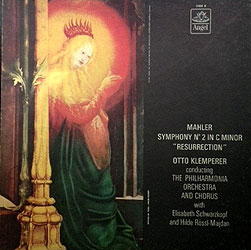
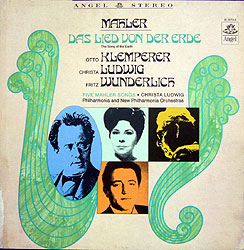 A resplendent Fritz Wunderlich leaps over the drunkard's vocal hurdles with masculine grace, languishes alongside the youthful revelers and rails at the world's foibles through the fog of drunken oblivion, and is complemented by Christa Ludwig whose deeply controlled power aches with timeless yearning, a distant observer suffused with calm while reflecting on the quirks of humanity. Despite its bifurcated genesis, Klemperer ties it all together with steady bearing offset by incisive detail and sharp inflection from which emerge the felicities of the orchestration. The ending is exceptional – rather than the usual gradual fade into the infinite of the contralto's repeated "Ewig � ewig �" ("Forever � forever �"), as with the prior Vox recording Ludwig and the orchestra maintain much of their volume and presence through the very end, as though refusing to let go of the last shreds of life until the last possible moment.
A resplendent Fritz Wunderlich leaps over the drunkard's vocal hurdles with masculine grace, languishes alongside the youthful revelers and rails at the world's foibles through the fog of drunken oblivion, and is complemented by Christa Ludwig whose deeply controlled power aches with timeless yearning, a distant observer suffused with calm while reflecting on the quirks of humanity. Despite its bifurcated genesis, Klemperer ties it all together with steady bearing offset by incisive detail and sharp inflection from which emerge the felicities of the orchestration. The ending is exceptional – rather than the usual gradual fade into the infinite of the contralto's repeated "Ewig � ewig �" ("Forever � forever �"), as with the prior Vox recording Ludwig and the orchestra maintain much of their volume and presence through the very end, as though refusing to let go of the last shreds of life until the last possible moment.
It seems ironic that Klemperer rejected a literary program for his scintillating rendition of the Mahler Fourth ("I believe that Mahler meant to convey nothing but pure tonal music, which he achieved in full measure") but wrote extensive fanciful agendas for the last two Mahler symphonies he recorded, although neither lives up to the intentions he expressed. Thus the "ecstatic spheres" he described for the first movement of his 1967 Ninth (which he extolled as the greatest of Mahler's symphonies) suffers from a lack of cohesive playing (especially surprising for the New Philharmonia) that compromises the impact of its climaxes, leaving a vague autumnal aura that muddles the tension that Mahler poured into his final work; the second movement is hardly "wild" and the burlesque third too straightforward to capture much "irony" and "sarcasm," although the deeply moving, whispered end of the finale does suggest the "majesty of death" invoked in Klemperer's description. His final word on Mahler, a 1968 Seventh (of which he had attended the rehearsals and premiere under the composer 60 years before), suitably begins in gloom but never emerges into light and activity. It's not just an issue of tempos (and at 100 minutes they are vastly inflated, even outlasting late Bernstein by 20 minutes) but a palpable lack of enthusiasm for the frequent outbursts (which, according to Klemperer, are to be "aggressive and combative in character") that need to defy the underlying sobriety of the funereal opening. The three middle movements are less impaired, although they lack much sense of their inherent mischief, playfulness and mysterious atmosphere. The finale bears its massive weight somewhat better, if only as support for all the bloat that has come before, but here, too, it's a stretch to discern Klemperer's "celebration and rejoicing throughout the movement."
Odds and Ends ~ For the record (so to speak),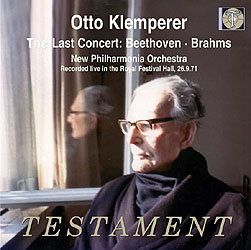
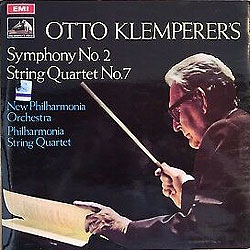 we should note that Klemperer and the Philharmonia also cut for EMI Mozart, Beethoven, Weber and Schumann overtures, Schubert's Symphonies 5, 8 and 9, Berlioz's Symphonie Fantastique, Strauss tone poems, Liszt and Schumann piano concertos with Annie Fischer, and Stravinsky's Symphony in Three Movements and Pulchinella Suite. While serving to further document the scope of his repertoire, none seems especially distinctive or exceptional.
we should note that Klemperer and the Philharmonia also cut for EMI Mozart, Beethoven, Weber and Schumann overtures, Schubert's Symphonies 5, 8 and 9, Berlioz's Symphonie Fantastique, Strauss tone poems, Liszt and Schumann piano concertos with Annie Fischer, and Stravinsky's Symphony in Three Movements and Pulchinella Suite. While serving to further document the scope of his repertoire, none seems especially distinctive or exceptional.
Although at the time he could not have known it would be his final concert, on September 26, 1971 Klemperer and the New Philharmonia presented in Royal Festival Hall, London a felicitous blend of the novel (Beethoven's seldomly-heard King Stephen Overture), the familiar (Brahms's Third Symphony) and a seed planted for the future (Israeli prodigy Daniel Adni's orchestral debut in Beethoven's Fourth Piano Concerto). Expectedly, all are appreciably slower than in his respective studio recordings yet nearly as well played, inviting a final round of musing between viewing his late work as monumental/patient/meticulous vs. lethargic/detached/fatigued. Two days later his last studio session was devoted to completing a recording of Mozart's Serenade # 11 in E-Flat, K. 375, an octet for winds that barely required the presence of a conductor at all. On July 6, 1973 he died as had Beethoven, during a thunderstorm, as though to place a final seal on his bond to the master with whom he will be forever identified.
As always, I'll take full credit and blame for the opinions and musical judgments in this article, while for the biographical and other information as well as the quotations I have cited I express my deepest gratitude for the following sources (dominated by Peter Heyworth, the foremost author on Klemperer's life, career and significance) :
- Biography and Outlook:
- Heyworth, Peter: Otto Klemperer: His Life and Times, Volume 1 – 1885-1933 and Volume 2 – 1933-1973 (Cambridge, 1983 and 1996) – Exhaustively researched and sourced, Heyworth's massive biography provides thorough coverage of Klemperer's life, with emphasis on his relationships, concerts and reviews rather than his recordings.
- Heyworth, Peter: "Klemperer, Otto" article in Stanley Sadie, ed.: The New Grove Dictionary of Music and Musicians (Oxford University, 2001) – a two-page condensation of the above.
- Heyworth, Peter (ed.): Conversations With Klemperer (Faber and Faber, 1973; rev. 1985) – a compilation of Klemperer's memories and opinions from interviews held in 1969, not unexpectedly avoiding mention of his illnesses, deportment and self-inflicted marital strains.
- Heyworth, Peter: "Otto Klemperer in Conversation with Peter Heyworth," chapter in Robert Chesterman, ed.: Conversations With Conductors (Robson, 1976) – additional reminiscences and observations prompted by questioning from Klemperer's primary biographer.
- Anderson, Martin: Klemperer on Music – Shavings From a Musician's Workbench (Toccata Press, 1986) – articles and other writings by Klemperer throughout his life, focusing half on his career and half on favorite composers and works; includes a list of his own compositions and dozens of artists' illustrations.
- Other info and commentary:
- Blyth, Alan: notes to Otto Klemperer's Symphony No. 2 / String Quartet No. 7 (EMI LP ASD 2575, 1970)
- Bruil, Rudolf A.: "RIAS Symphony Orchestra" on the Remington Site
- Crawford, Dorothy Lamb: A Windfall of Musicians – Hitler's �migr�s and Exiles in Southern California (Yale, 2009)
- Kurakin, Adam: notes to Otto Klemperer: Die Kroll-Jahre (Symposium CD 1042, 1988)
- Osnato, Raymond J.: notes to The Young Otto Klemperer (Koch CD 3-7053-2, 1991)
- Schonberg, Harold: The Great Conductors (Simon & Schuster, 1967)
- Discographies:
- Locke, George A.: A Discographic Listing of Klemperer's Sound Recordings and Film Appearances – Generously posted on the internet, including detailed matrix numbers and LP and CD issues of commercial releases of Klemperer recordings.
- Gray, Michael H.: Discography: commercial recordings by Otto Klemperer – The basis for the Locke discography; the relevant portion is included as an appendix to each volume of the Heyworth biography.
- Unger, Werner and Dick Bruggeman: Otto Klemperer (1883-1973) Comprehensive CD Discography (Archiphon, 2018) – based on the Gray discography as re-edited by Locke and further updated, this covers both studio recordings and recorded concerts, but only as available on commercial CDs. Generously posted on the Internet in versions organized by date and by composer.
- HI-HO [sic – a Japanese site by an unidentified author] – a condensed version listed by composer but adding known private recordings of live concerts.
- Recordings:
- Acoustical and Early Electrical 78s: Otto Klemperer - The Complete 78rpm Recordings (Berlin: 1924-32) (Archiphon 121/25; 1980)
- The Kroll Years: as above, plus Otto Klemperer: Die Kroll-Jahre (Symposium 1042, 1988) and The Young Otto Klemperer (Koch 3-7053 2; 1991)
- Los Angeles: Klemperer Rarities – Los Angeles, Volumes 1 and 2 (Archiphon ARC-WU 027-28 and 029-30, 2012); Klemperer in Los Angeles (Archiphon ARC-WU 114-15; 2011)
- Budapest: Klemperer Rarities – Budapest, Volumes 1 - 11 (Archiphon CDs)
- Vox Recordings: Otto Klemperer – The Vox Recordings (Vox Legends CD6X 3605; 2002); Klemperer Rarities – Paris 1946 Volumes 1 and 2 (Archiphon ARC-WU 172-3 and 174; 2014); various Archiphon "LP Pure" CDs (alas, as on most of Archiphon's CDs "Pure" here comprises straight transfers with all shellac and vinyl flaws)
- Concertgebouw concerts: Klemperer in Amsterdam, Volumes 1 - 3 (Archiphon ARC-WU 076-7, 026); Mahler Symphony # 2 (Decca Historic 425 970 2; 1982)
- RIAS: Otto Klemperer (1st Master Release: RIAS recordings from Berlin, 1950-1958) (Audite 21408; 2011)
- EMI: various Angel LPs; various EMI Studio and EMI Classics CDs (1989-92)
- Klemperer rehearsal with a WPA orchestra: Klemperer Rarities – New York, Vol. 3 (Archiphon ARC-WU 042, 2005)
- Klemperer's compositions (in private performances): Klemperer – Own Compositions, Volumes 1 - 4 (Archiphon ARC-WU 149, 150-1, 152-3, 154; 2013)
- Klemperer's final concert: Testament CD SBT2 1425 (2008)
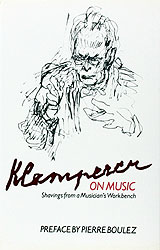
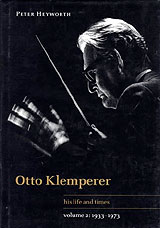
Please note: These are the audio sources I used; the above discographies list others. Many selections are on YouTube. The Archiphon and Audite CDs currently are on Spotify (where I heard them) but beware: unless you subscribe to their premium platform (I did), prepare to be assaulted by an onslaught of ads that seem perversely designed to annoy in their positioning, frequency and content; do advertisers truly believe that listeners will be favorably impressed when the bliss of a Bruckner Adagio leads right into the thump-thump-thump of a deafening disco bed?
Copyright 2019 by Peter Gutmann
copyright © 1998–2019 by Peter Gutmann. All rights reserved.